March 2020 Newsletter
Welcome to the March 2020 issue of the Global Washington newsletter.
IN THIS ISSUE
Letter from our Executive Director
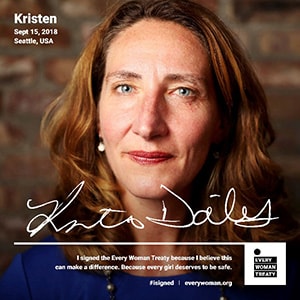
To honor International Women’s Day, Global Washington has launched a month-long issue campaign to elevate the importance of ending gender-based violence. This month we are also celebrating the 25th anniversary of an historic gathering in Beijing that was a threshold moment for women’s rights – the Beijing Declaration, which set out specific goals to end violence against women globally.
Despite the tremendous progress that has been made since the Beijing Declaration, we still have a long way to go. The World Health Organization estimates that globally more than one in three women has experienced physical and/or sexual violence in her lifetime.
Today, numerous Global Washington members are part of a global movement to end gender-based violence. And it does feel like a movement. Some of the changes are happening at the grassroots community level, while others are focused on shifting national and international policy.
Please take the time to learn about the effective strategies that GlobalWA members are using to end gender-based violence around the world. In the articles below, we take an in-depth look at how the global network of Vital Voices elevates women leaders around the world to effect positive change. You will also find out how this month’s Goalmaker, Amanda Klasing from Human Rights Watch, became involved with the global women’s rights movement. And finally, I hope you will take the time to watch a video interview with Rikki Nathanson, a pioneering transgender activist from Zimbabwe, who is on the board of OutRight Action International.
Also this month, we have decided to host an event that will be online only to support social distancing in light of the Coronavirus in Washington state. Please join on March 18 for a virtual event on this topic. We will have speakers representing OutRight Action International, Rise Beyond the Reef, Seattle International Foundation, and CARE.
I hope you are staying healthy, and I also encourage you to stay connected online to the GlobalWA community.

Kristen Dailey
Executive Director
Back to Top
Issue Brief
Strategies for Ending Gender-based Violence Globally
By Joanne Lu
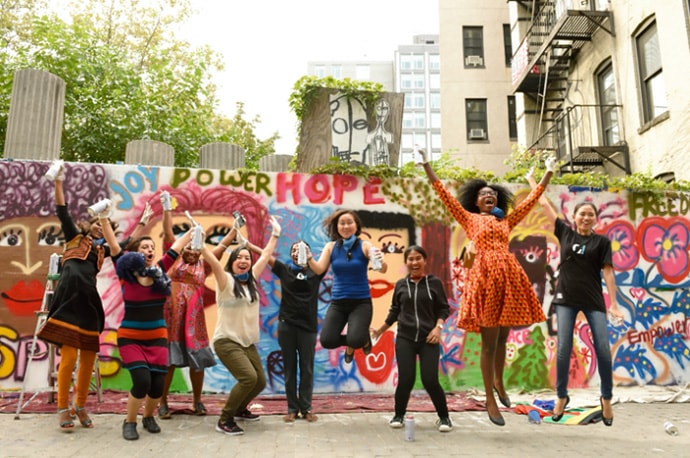
A workshop in NYC, led by Panmela Castro, a graffiti artist who was a victim of domestic violence. Vital Voices connected her with other graffiti artists and helped her establish Artefeito, an organization that uses art to transform culture for social progress. Photo courtesy of Vital Voices Global Partnership.
Twenty-five years ago, tens of thousands of women from around the world decided it was beyond time for women to have a seat at the table of their own wellbeing and advancement. On September 4, 1995, they traveled to Beijing, China to attend the U.N.’s Fourth World Conference on Women, a critical event that would later be recognized as a significant turning point for the global agenda for gender equality.
It was at that conference that then-First Lady of the United States Hilary Clinton delivered a famous speech in which she declared that, “human rights are women’s rights, and women’s rights are human rights.” Also at that meeting, 189 countries unanimously agreed to adopt an agenda that set out to achieve gender equality in 12 critical areas, including violence against women. Sixty-eight countries even made actionable commitments, such as a six-year, $1.5 billion program by the U.S. to fight domestic violence. Perhaps most importantly, some experts say the Beijing Declaration and Platform for Action made violence against women a matter for public discussion, instead of just a private, family issue.
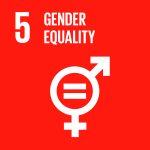
Although the Beijing Declaration continues to be celebrated as a major step forward for women, no country has achieved equality yet, and violence against women and girls, in particular, remains an alarming global problem.
Femicide Watch reports that in 2017, an estimated 87,000 women around the world were murdered – more than half of them (50,000) by an intimate partner or family member. This means that every single day, 137 women are being killed by their own family.
The World Health Organization (WHO) also estimates that more than one in three women have experienced physical and/or sexual intimate-partner violence or sexual violence by a non-partner in their lifetime. But the estimates vary by region and in some countries, intimate-partner violence has affected up to 70 percent of women.
It’s true that gender-based violence (GBV) includes more than just domestic violence against women. CARE defines GBV as “a harmful act or threat based on a person’s sex or gender identity.” So, it certainly includes violence against men and boys, such as the targeted killing of men and boys in conflict or sexual violence against male refugees. However, GBV does disproportionately affect women, girls and other minorities (particularly LGBTIQ people), largely because they are disempowered by systemic gender inequality. And it can take on many different forms, including street harassment, human trafficking, female genital mutilation, child marriage, marital rape, honor killings, psychological bullying, and cyber harassment.
What’s more, GBV has serious repercussions on survivors. For example, the WHO found that women who have experienced intimate-partner violence report higher rates of depression, having an abortion and contracting HIV than women who have not. Many survivors also face social stigma.
Since the Beijing conference in 1995, governments, NGOs and intergovernmental organizations have adopted many strategies to fight gender-based violence and bring it to an end globally, all of which must work together to change societies that allow gender-based violence to continue.
To tackle a problem, one must first understand the scale and scope of the problem. But GBV is notoriously under-reported because of barriers like social stigma and limited access to services and resources. This lack of data means that it’s nearly impossible to accurately assess if global rates of GBV are increasing or decreasing over time. For this reason, there has been a push to collect more data. Researchers are finding better ways to collect information, like calling violence-against-women surveys “women’s health surveys” instead, and organizations, like Human Rights Watch, are compiling the data into reports for use in advocacy. OutRight Action International, an advocacy group that fights for the rights of LGBTIQ people around the world, also does a lot of work to fill the huge gaps in data regarding violence against sexual and gender minorities.
As a result of improved data collection and public conversations about GBV after Beijing, two-thirds of countries have adopted laws to stop domestic violence. But Every Woman Treaty wants to take it a step further by creating a legally binding global treaty that requires countries to prevent and address violence against women and girls. In the meantime, organizations like OutRight and Vital Voices are working with institutions on the ground to make sure that the laws are actually being enforced and that women, girls, and LGBTIQ individuals have access to the help and services they need.
But ending GBV is more than just a legal battle; it also requires resources, including financing. Although funding for gender equality and women’s empowerment is increasing, women’s rights organizations are still “significantly underfunded” compared with other development programs, according to the Equality Institute.
Ending GBV also requires a shift in cultural norms and attitudes toward gender. That’s why Breakthrough is using pop culture, media and technology to challenge gender-based norms in the U.S. and India and to help tackle violence. For example, their first campaign in India in 2008 was a series of TV ads called “Bell Bajao!” (or “Ring the Bell!”), which promoted the idea that violence is everyone’s business. So, if you witness your neighbor being violent toward his wife, you can help by creating an interruption, like ringing their doorbell. Breakthrough is also helping women in India realize for themselves that violence against them by their husbands is, in fact, a problem and should not be accepted.
To accelerate changes from the ground up, some organizations are focused on supporting grassroots activists. For example, the Seattle International Foundation (SIF) has been partnering with the U.S. Department of State for years on a program called Mujeres Adelante (or “Women Forward” in Spanish), which addresses GBV by hosting grassroots women leaders from Central America in the U.S. for two weeks of leadership training and exchanges. The goal, according to SIF, is to create a more organized and powerful network of change agents across the region who can support each other in their efforts to end GBV.
While women become more empowered to assert their rights, many organizations are also realizing the importance of engaging men and boys in the conversation in order to break the cycle of violence. After all, violence in many cases is learned behavior. In Lebanon, for example, a study found that men who had witnessed their fathers beating their mothers during childhood were three times more likely to perpetrate physical violence. However, CARE is helping men and boys redefine masculinity through family economic initiatives that teach couples how to run their households as equals, through male support groups that have open discussions about GBV and by facilitating conversations about GBV between male change agents and political and religious leaders. In patriarchal systems, it’s especially important for men to lead other men by example. That’s why Vital Voices, an organization that invests in women leaders, puts a big emphasis on male allies when they train police officers, lawyers, judges, and religious leaders – professions still dominated by men in many countries – on how to prevent and respond to violence against women.
Although there’s still a long road ahead in the fight to end GBV, experts are encouraged that at the very least, social change has been initiated. And as all of these strategies continue to work together to address the many facets of violence, changemakers are optimistic that the momentum will build: new generations of girls will grow up knowing that they have a right to safety, education, and decision-making about their own wellbeing, and new generations of boys will learn how to be allies. But making that a reality will require sustained efforts to actively change norms and uphold the rights of women, girls, and minorities everywhere.
***
The following Global Washington members are working to end gender-based violence around the world:
Awamaki
Awamaki partners with women’s artisan cooperatives to teach them to start and run their own businesses. Awamaki invests in women’s skills, connects them to markets and supports their empowerment. Through Awamaki’s programs, artisan women from marginalized and remote villages learn business and leadership skills so they can earn an income and gain a voice in their households and their communities. The organization’s trainings include gender-based violence awareness and women’s rights topics, and its income-generating programs allow women to build successful futures and create a better life for themselves and their children.
Every Woman Treaty
Every Woman Treaty is a coalition of more than 1,700 women’s rights activists, including 840 organizations, in 128 nations working to advance a global binding norm on the elimination of violence against women and girls. The organization’s working group studied recommendations from the United Nations, the World Health Organization, and scholarly research on how to solve the problem of violence against women and girls, including trafficking and modern slavery, and found that a global treaty is the most powerful step the international community can take to address an issue of this magnitude.
Human Rights Watch
Human Rights Watch (HRW) fights to end violence against women and girls, advance women’s right to health care, and promote women’s economic and social rights. HRW’s method is straightforward. The organization investigates violations of women’s rights, talking to the women and girls directly affected on the ground in countries around the world. HRW documents its findings in hard-hitting reports with detailed recommendations. Then HRW uses these reports—and targeted media outreach—to generate pressure for reform by the entities that perpetrate abuses against women. All HRW’s work is intersectional and is done in partnership with local organizations and activists. HRW researchers fight sexual harassment in the workplace and abuses in garment manufacturing to combatting human trafficking; work to end child marriage, and defending women’s access to land and the right to health, including sexual and reproductive health. HRW’s latest work is uncovering the new intersections between technology and gender-based violence, including digital stalking and on-line harassment, as it continues to document abuses and foster coalitions that protect, defend, and fight for women’s rights around the world.
Kati Collective
Kati Collective improves systems across global development by providing experienced, strategic, and pragmatic action focused on three of the most important drivers of change: women, digital, and partnerships. In all of its engagements, Kati Collective applies a gender lens, thinking strategically about how to engage men and boys, while concurrently supporting women and girls in LMICs. Kati Collective’s work concentrates on culturally relevant technology for social impact, focusing on girls’ and women’s empowerment applications for effectively educating communities and maximizing outcomes for the underserved across the globe. Gender-based violence, which is faced by women globally, is not a female problem – it is a human problem, rooted in the attitudes, cultural norms, and behaviors of men worldwide. When men and boys are educated about ingrained sexist and systemic biases, they begin to see how they can partner in stopping these behaviors and practices from harming the next generation. Kati Collective approaches partnerships with the goal of aligning agendas regarding GBV and other female-centric issues forward collectively. Local and global perspectives must come together for impactful and lasting systemic change. Kati Collective provides its clients with perspective and experience, as well as the strategies and tools needed to improve outcomes for women on a global scale.
Landesa
Landesa champions and works to secure land rights for millions of those living in poverty worldwide, primarily rural women and men, to promote social justice and provide opportunity. Evidence shows that women’s land rights can transform power dynamics within households and communities, improving women’s status and their own perceptions of their power. This empowerment forms the bedrock for greater economic opportunity for women, and can also contribute to better health outcomes, including potential reductions in gender-based violence, rates of HIV infection, and other threats to women’s safety. In West Bengal, India, Landesa is working with USAID and PepsiCo to raise awareness of issues related to GBV in agricultural supply chains. This work includes developing guidance documents for a project that is helping women farmers learn skills to participate in PepsiCo’s potato supply chain. Guidance has been tailored both for field staff who work directly with farmers and for management staff, including training materials developed in collaboration with a local CSO to help field staff address GBV. Across more than 50 countries, Landesa has helped strengthen land rights for more than 180 million families.
Mercy Corps
Mercy Corps is a global team of nearly 6,000 humanitarians working in more than 40 countries around the world. From Colombia to the Central African Republic, Mercy Corps partners with local communities to build strong, equitable, and protective societies in which women and girls can thrive. In order to combat Gender-Based Violence (GBV), Mercy Corps works to address the root causes of GBV and connect survivors with the vital resources and services they need. In Lebanon, Mercy Corps hosts a series of dialogue sessions for Syrian refugees in order to bring awareness to GBV and provides case management, connecting survivors to medical and legal services, psychological support and safe housing.
OutRight Action International
Lesbians, bisexual women and transgender (LBT) people around the world often face violence and exclusion in many spheres of their lives, fueled by laws that criminalize same-sex relations and gender non-conformity and encouraged by governments who tolerate, endorse, or directly sponsor the violent clamp-down on those who do not follow prevailing societal norms. Often LBT people are excluded or driven away from needed services and social support, and violence often goes unreported. They are also often denied access to justice based on archaic laws that limit the definition of rape while also delegitimizing same-sex and queer intimacy. OutRight Action International works with grassroots partners in Asia and the Caribbean to ensure that the experiences of LBT people are included in anti-gender-based violence work. For example, in 2019, OutRight and its Caribbean partners launched the Frontline Alliance: Caribbean Partnerships Against Gender Based Violence project to engage first responders, local government officials and others with a focus on domestic violence, family violence and intimate partner violence and to advocate for improvement in policies and protocols through engagement in research, trainings and strategic campaigning. OutRight has also documented the violence and exclusion LBT women face in Asia, worked with grassroots partners to improve domestic violence protections for LGBT people in Sri Lanka and the Philippines, Myanmar and China, and is currently launching a regional platform of experts on SOGIE and GBV in Asia.
Oxfam America
Oxfam America’s work to advance gender justice is multifaceted and tailored to the people Oxfam serves. In some countries, Oxfam is the largest and most prominent organization to take a stand for women and gender-diverse people, and alongside them, often supporting the infrastructures of burgeoning movements. In other countries, like Sri Lanka, Oxfam helps rethink entrenched systems and remap biases to shift attitudes and overcome barriers. In all places, Oxfam strives for sustainable change. Oxfam does so first by acknowledging women, girls, and feminist actors as effective social change agents who must have a hand in ensuring their own rights and in the development they most want to see – development that will transform their families, communities and countries. Oxfam’s gender-based violence (GBV) work is focused on working with women’s rights organizations and feminist movement actors in 30 countries to challenge and transform harmful social norms. Oxfam’s focus on ending GBV is on addressing changes in social norms that perpetrate violence against women in creative ways and engaging feminist activists a youth at the local level. Oxfam’s global, regional, and national GBV work includes: 1) innovative global and national campaigning activities, like the Enough campaign
Working with digital influencers to counter anti-rights actors; 2) engaging and supporting the agendas of women’s rights organizations and feminist movement actors; 3) collaboration with feminist funds to provide small, flexible grants to young feminist organizers running campaigns; and 4) supporting the mobilization of young people at regional level.
Seattle International Foundation
Seattle International Foundation (SIF) champions good governance and equity in Central America through support for rule of law and the strengthening of civil society. When security and rule of law deteriorate in the Northern Triangle of Central America, women face not only systemic violence from powerful gangs, impunity and government repression, but pervasive domestic and sexual violence as well. This has exacerbated the tendency to migrate, despite a high likelihood of facing additional violence en route and a slim likelihood of obtaining asylum in the United States. SIF has committed to addressing and mitigating this reality through its multi-prong approach and through its key initiatives: the Central America Donors Forum, Central America in Washington, D.C., Central America and Mexico Youth (CAMY) Fund, Centroamérica Adelante and the Independent Journalism Fund.
Vista Hermosa
Vista Hermosa is a family foundation located in Pasco WA, established by Ralph and Cheryl Broetje in 1990 to invest in the growth of flourishing communities. Informed by teachings of servant leadership, healing centered engagement and empowered worldview, Vista Hermosa takes a holistic approach to understanding and reconciling people’s connections to self, others, God, and place (shalom). Vista Hermosa accompanies very marginalized groups of people to discover who they are, find their voice, and be the solutions to their own wellbeing and development. The foundation currently funds partners in Mexico, Haiti, India, and East Africa, as well as the U.S. One of its strategies to address gender-based violence is through supporting the adaptation of SASA! (originally developed in Uganda), a community-led awareness, education and action methodology. Vista Hermosa funded the adaptation for the Haitian context and most recently for Mexico/Central America. The foundation is currently assembling a group of funders to support a cohort of regional NGOs to implement this evidence-based curriculum that addresses power imbalances between women and men in communities. Vista Hermosa also supports a range of organizations working on child and sex trafficking, FGM, and new masculinities.
Vital Voices
Vital Voices is a global movement that invests in women leaders solving the world’s greatest challenges. Vital Voices understands that, in order for the world to embrace women’s full potential across industries and issues, gender-based violence (GBV) must be eliminated. Vital Voices works with women leaders and male allies to ensure that victims and survivors of GBV gain better access to services, protection and the justice they deserve. Vital Voices oversees key programs implemented in partnership with local leaders to deliver on this work. The Voices Against Violence Initiative champions innovative solutions to end GBV. Within Voices Against Violence, Vital Voices provides and administers Urgent Assistance Funds to survivors of extreme cases of GBV who do not have alternative means of support for immediate, short-term needs such as medical expenses, psychosocial counseling, emergency shelter and more. Also through Voices Against Violence, Vital Voices hosts Justice Institutes – interactive training programs that promote holistic response to violence and exploitation by convening judges, prosecutors, law enforcement and service providers and other stakeholders across the justice system to focus on victim safety and offender accountability. Vital Voices also oversees the Global Freedom Exchange, which provides a dynamic educational and mentoring experience for emerging and established women leaders who are on the forefront of global efforts to prevent and respond to the destructive crime of human trafficking. These programs support Vital Voices’ work protecting human rights so that everyone can enjoy the safety and security they deserve.
Back to Top
Organization Profile
Vital Voices Invests in Women Leaders, Empowering Them to Turn Their Bold Visions for Change Into Reality
By Joanne Lu
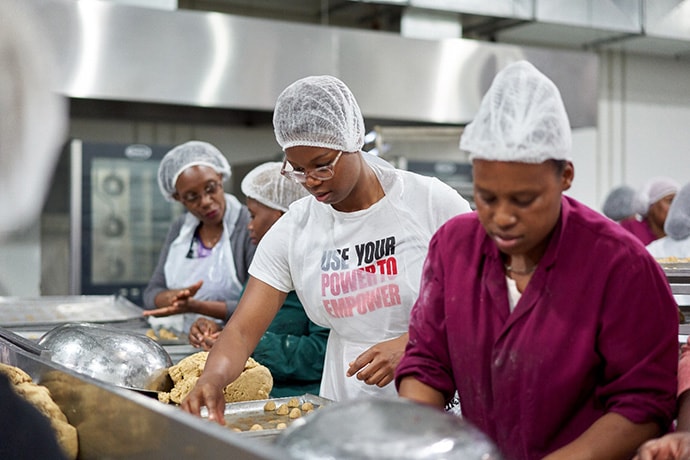
Vital Voices staff and Global Freedom Exchange Fellows from countries across Africa gathered in Cape Town for a “Regional Activation.” Pictured here, the group visited a women-owned, women-run social enterprise, called Khayelitsha Cookie Company. Photo courtesy of Vital Voices Global Partnership.
Alyse Nelson was just a college student when she heard then-First Lady Hilary Clinton’s landmark speech on women’s rights at the UN’s Fourth World Conference on Women in Beijing in 1995: “If there is one message that echoes forth from this conference, let it be that human rights are women’s rights, and women’s rights are human rights, once and for all.”
Little did she know that the fire that she felt in that moment would forever change her life, setting her on a quest “to use power to empower and to use voice to give voice.”
Just two years after the conference, Nelson worked with several other women, including Clinton, then-Secretary of State Madeleine Albright and Ambassador Swanee Hunt, to establish the Vital Voices Democracy Initiative, a State Department program which sought to promote women’s advancement as a U.S. foreign policy goal. By 1999, the program was ready to become an independent non-governmental organization, Vital Voices Global Partnership, a network-based organization on a mission to “invest in women leaders who are solving the world’s greatest challenges.” Vital Voices today supports women leaders through a myriad of programs – including fellowships, grants and training – such as individualized investment and activations through their international network to expand leaders’ skills, connections and visibility. Vital Voices works to turn women leaders’ daring vision for change into bold realities.
Today, Nelson is the president and CEO of Vital Voices, now a vast global network of more than 18,000 women leaders (and male allies) in 182 countries and territories. But their resounding impact is far greater as many women leaders are changing the lives of thousands and millions more, says Nicole Hauspurg, Vital Voices’ Director of Justice Initiatives on the Human Rights team. After all, she says, women are multipliers; often demonstrating a unique ability and willingness to pay forward their opportunities in order to have a broader impact on their communities. This attitude is exhibited even in the way that new women leaders connect with Vital Voices. While some women cold-call and others respond to open applications for fellowships or programs, the primary way Vital Voices identifies women leaders is through other women leaders in the network.
Specifically, Vital Voices supports women who are who are creating change in four key ways: they are boosting economic empowerment and entrepreneurship in their communities; they are promoting human rights and ending gender-based violence (GBV); they are making or influencing policy and serving as political leaders; or they’re confronting issues and want assistance advancing their own leadership as women. To correspond with these focus areas, Vital Voices has several teams that operate differently based on their mandate and the needs of the women they work with around the world.
For example, one of the many efforts Vital Voices’ human rights team oversees is an Urgent Assistance Program that provides emergency financial support to survivors of extreme GBV around the world. This program and others are made possible through the Voices Against Violence: The GBV Global Initiative, a public-private partnership between Vital Voices, the Department of State, and the Avon Foundation for Women. If an individual is experiencing an extreme form of GBV, they – or an organization or individual that is helping them – can contact Vital Voices’ GBV experts with linguistic support for short-term lifesaving assistance for their needs in the immediate aftermath or threat of extreme violence.
“The reality is we have varied and diverse program offerings because we realize that the needs of women leaders around the world are not one-size-fits-all,” says Hauspurg. “Women everywhere are blazing trails around solutions that are responsive to the local, national, regional and global challenges that impact them and the intersecting communities of which they are a part.”
Vital Voices’ program offerings have expanded to reflect what the women in their network have expressed they need support with. Most of the human rights teams’ work, therefore, focuses on domestic violence, sexual violence, human trafficking, harmful traditional practices, female genital mutilation and early and forced marriage. Although other teams engage with human rights advocates and defenders who promote a broader spectrum of human rights, the human rights team works exclusively on GBV.
“We realized that one in three women experience violence in their lifetime, so if we want women to advance in all areas of society – to get to be entrepreneurs, to get to be political leaders – fundamentally, we have to create an environment that’s free of violence and exploitation,” says Hauspurg.
One way that Vital Voices is tackling human trafficking, for example, is through its Global Freedom Exchange, a two-week educational and mentoring program in partnership with Hilton that takes anti-trafficking advocates – many of whom identify as survivors of trafficking themselves – to three U.S. cities, each with their own unique challenges and best practices in preventing and responding to trafficking. The program is complemented by regional programming as well as competitive grants, which support participants as they adjust the models they observed to their own contexts. Among the program’s alumni are two Seattleites: Wendy Barnes, who is the program director of Dignity Health’s Human Trafficking Response Program and Alisa Bernard, the director of education and partnerships at the Organization for Prostitution Survivors.
Also through VAV, Vital Voices has conducted two dozen Justice Institutes on Gender-Based Violence in 14 countries. Justice Institutes train judges, prosecutors, law enforcement, advocates and other community leaders involved in the justice system on how to more effectively identify, investigate and prosecute GBV – and why it’s important to do so. Especially with the help of male allies, Justice Institutes are helping to shift societal attitudes and enforce laws and policies that either don’t exist or aren’t implemented to their full extent.
Brazil, for example, didn’t have a domestic violence law until 2006. When the law was finally introduced, it wasn’t enforced and many women had no idea they had rights. Says Hauspurg, “Sometimes laws need help keeping their promises.” That inspired interest in Justice Institutes in Brazil, of which there have been five implemented in partnership with Vital Voices and local stakeholders. Moreover, it inspired Panmela Castro, a graffiti artist who was a young bride and victim of domestic violence, to begin painting beautiful murals late at night that depicted women as survivors and educated them about their rights under the new law. But to really scale her impact, Panmela needed leverage, so Vital Voices connected her with other graffiti artists and helped her establish Artefeito, an organization that uses art to transform culture for social progress.
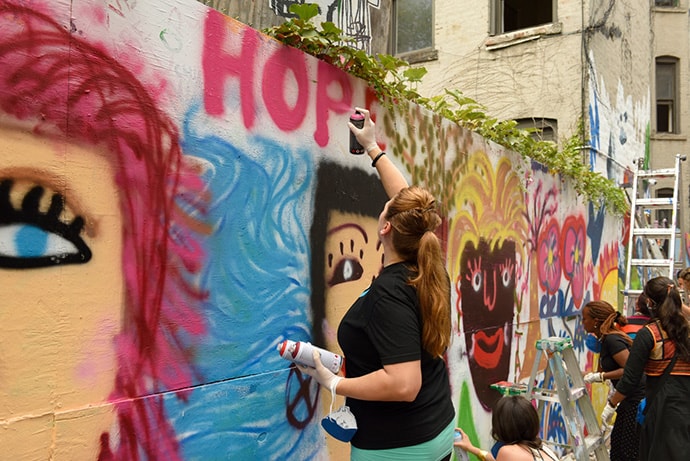
A workshop in NYC, led by Panmela Castro, a graffiti artist who was a victim of domestic violence. Vital Voices connected her with other graffiti artists and helped her establish Artefeito, an organization that uses art to transform culture for social progress. Photo courtesy of Vital Voices Global Partnership.
As we approach the 25th anniversary of the conference that sparked this journey for Alyse Nelson and the tens of thousands of women, like Panmela, who have been impacted by her work, Vital Voices is looking for ways to continue building on the momentum of the last 25 years. One way is by adding new and different types of actors to their already extensive list of multi-sectoral partners, which currently include the U.S. Department of State, CARE, Avon, Hilton, Uber, Promundo, and Global Fund for Women, among others. They’re also always looking for more ways to include more women, whether by seeking creative methods of outreach, ensuring that as much as possible programming and services can be delivered in local languages, providing different forms of transportation to their programs or using pseudonyms for survivors – because the more women leaders they can reach, the more those women can pay it forward. And that’s the power of empowering women.
Back to Top
Goalmaker
Amanda Klasing, Human Rights Watch Acting Co-Director, Women’s Rights Division
By Penny Carothers
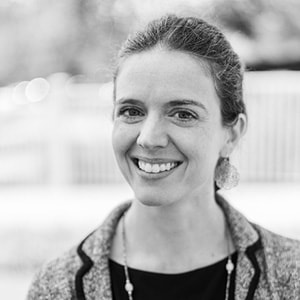 Growing up in South Texas close to a fluid border, Amanda Klasing saw deep inequality firsthand and wanted to do something about it from an early age. From a deeply religious family whose faith was informed by social justice, she always knew she’d have a career and a life that included service. What she didn’t realize then was that her life’s work would require her to face an inherent tension in her upbringing.
Growing up in South Texas close to a fluid border, Amanda Klasing saw deep inequality firsthand and wanted to do something about it from an early age. From a deeply religious family whose faith was informed by social justice, she always knew she’d have a career and a life that included service. What she didn’t realize then was that her life’s work would require her to face an inherent tension in her upbringing.
This tension was a fact of life in her childhood, streaming from the radio and from the front seat of the family car. On rides to and from baseball practice—on a team where she was the only girl—she heard messages like, “feminazis are going to ruin the world,” from the family’s favorite radio program, The Rush Limbaugh Show. “I grew up in a very conservative household where the worst thing that you could be was a feminist,” she explained. “At the same time, my dad also encouraged me to pursue anything that I wanted to, whether it was sports or leadership or a scholarship. Whatever it was, there was no distinction in the way that he saw my abilities and my opportunities and the way he saw my brother’s.”
Buoyed by her parents unflagging belief in her, Klasing excelled as a student and discovered human rights as a framework for understanding the social justice messages of her youth. While in law school and graduate school, she focused on human rights advocacy, which led her to Human Rights Watch (HRW) where she is now acting co-director of the women’s rights division.
Human Rights Watch’s Women’s Rights Division (WRD) has been protecting the rights of women and pushing for gender equity for 30 years. Their in-depth research and targeted advocacy have achieved impact around the world, from global treaties protecting the rights of women workers to national-level policy changes to advance reproductive rights, end child marriage, increase access to education, and protect women from violence.
At HRW Amanda has carried out research and advocacy on a number of human rights issues including the First Nations water crisis in Canada; sexual violence and other forms of violence against women displaced by conflict in Colombia; the relationship between women’s and girls’ human rights and access to good menstrual hygiene management; and the rights to water and sanitation in schools.
Amanda began documenting and elevating the experiences and the voices of those impacted by human rights violations, and she’s always learned from the people she meets. During research and advocacy work in Colombia, Amanda met Angélica Bello, a woman who was targeted by paramilitary successor groups in Colombia for her activism. Angélica and her daughters were victims of sexual violence. Rather than stay silent, she used her voice to call for an end to impunity for perpetrators. Angélica was a tireless advocate for survivors, helping them pursue justice for rape or assault and for increased access to protection and medical help. Despite threats against her life, Angélica kept highlighting the issue of sexual violence and the protections victims needed from the government. For her work, she was harassed and threatened relentlessly. Angélica died never receiving the psychosocial support she needed and was advocating to make available to all survivors. A year after Angélica’s death, a bill protecting the rights of survivors of sexual violence passed into law.
Several years later Amanda met Carol, a young mother in Brazil. Carol’s second daughter, Gabi, was born with congenital Zika syndrome. “Carol knew that something deeply wrong had happened, that there were so many government failures leading up to the Zika outbreak and afterward, and that her child and family have a right to receive services,” Klasing explained. Amanda worked with Carol to tell the stories of women and babies affected by Zika in northeastern Brazil and to create an HRW report on the issue. Amanda says, “I saw amazing growth in Carol and in her work with us and her community—the change that she will continue to have with other children and families is phenomenal and exponential.”
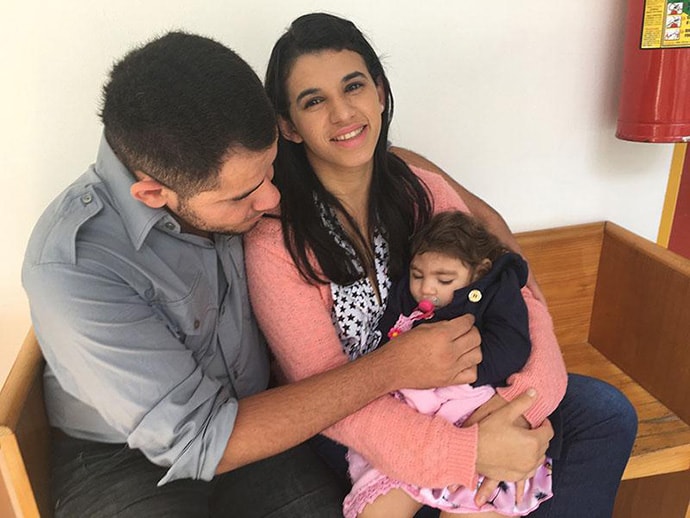
Maria Carolina Silva Flor and Joselito Alves dos Santos with their 18-month-old daughter, Maria Gabriela Silva Alves, pictured after the launch of the Human Rights Watch report Neglected and Unprotected, July 2017. © 2017 Amanda Klasing/Human Rights Watch
As Amanda emerged as a leader in the women’s rights movement , she continued to grapple with a tension she sees in her work with women like Carol and Angélica: incredible human rights violations juxtaposed with the strength she sees in survivors as they persevere and demand respect for their rights even while facing daily indignities and atrocities. This is what is at the heart of the human rights movement: survivors seeking justice and to be seen as having the same inherent dignity as all human beings. It’s one of the reasons she was drawn to and keeps doing the work. “The brave women and girls who I have spoken to throughout my career continue to motivate me and in particular the leaders that rise out of movements at the grassroots level. I have felt very fortunate to work with women’s rights advocates and I am amazed by their fortitude and their ability to hope for a different world.”
Despite the difficulties, Amanda is encouraged by advances in centering human rights conversations on impacted populations. HRW has always strived to promote a connected, outspoken, and effective global women’s rights movement that is intersectional and inclusive. She says, “My personal and professional goal is to see human rights organizations adapt to be in service to a movement and to the leaders of directly impacted populations. There’s so much space for innovation and opportunity to bring our research methodologies and unique strengths to partner for new approaches…My colleagues at HRW are always willing to evolve and be influenced by our partners.”
You can say the same about Klasing. Though she prefers to talk about her work and the strength of grassroots leaders rather than herself, it is striking that in her role at HRW Klasing broadcasts a different kind of story than the one she grew up listening to on the radio. The tension between the messages she heard as a child and those she shares now may be strong, but the connection is undeniable. She summed it up best herself in a 2017 article for Women’s eNews when she said, “My father exposed me to what the world thinks of women who fight too hard for equality, but also raised me to be strong enough to be one of those women.”
Back to Top
Welcome New Members
Please welcome our newest Global Washington members. Take a moment to familiarize yourself with their work and consider opportunities for support and collaboration!
Fanikia Foundation
Fanikia Foundation provides support to underprivileged individuals and communities in Tanzania and the United States through education, training, and information. Its main goal is to eliminate poverty and to empower individuals in specific communities. Different strategies are needed to tackle these issues. The foundation partners with like-minded organizations to eliminate poverty and illiteracy. Currently Fanikia Foundation is focusing on two programs: “Educate a Girl,” a program based in Tanzania and “Drive to Higher Education,” based in the United States. fanikiafoundation.org
Vital Voices
Vital Voices is a global movement that invests in women leaders who are solving the world’s greatest challenges. Guided by the belief that women are essential to progress in their communities, Vital Voices identifies women with a daring vision for change and invests in them to make their vision a reality. Through long-term investments that expand each leader’s skills, connections, and visibility, Vital Voices accelerates and scales their impact. vitalvoices.org
Back to Top
Member Events
Many member events in March have been cancelled or are now being held virtually. You can find out about upcoming events on our Community Calendar.
Back to Top
Career Center
Research and Impact Officer, Global Partnerships
Director of Communications and Marketing, Tearfund
Assistant, VillageReach
Global Entersprise Director, Days for Girls
Enterprise Program Administrative Assistant, Days for Girls
Check out the GlobalWA Job Board for the latest openings.
Back to Top
GlobalWA Events
March 18: (Virtual Event) Proven strategies for stopping gender-based violence
Back to Top
Climate justice means protecting the future of fish
Posted on February 18, 2020.
By Kelly Pendergrast, Communications Consultant at Future of Fish
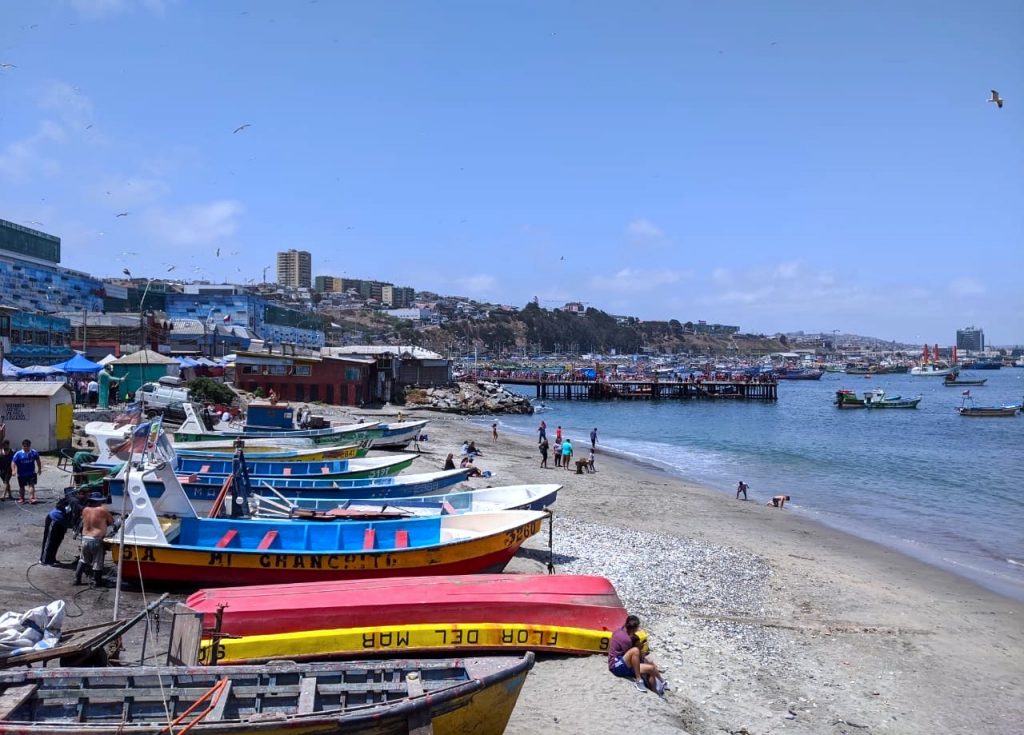
Boats arranged on the beach in Paita, Peru. Photo courtesy of Future of Fish.
Billions of people depend on fish as a critical source of protein. From lobster divers in Belize to handline mahi-mahi fishers in Peru, communities around the world feed themselves and make a living from the fish they pull from the ocean every day. But these livelihoods are under threat. Climate change is already wrecking havoc for coastal communities in developing countries, with rising seas damaging dockside infrastructure and warming waters driving away traditional fish stocks. The result is loss of income, food, and in many cases, cultural heritage.
Continue Reading
February 2020 Newsletter
Posted on February 6, 2020.
Welcome to the February 2020 issue of the Global Washington newsletter.
IN THIS ISSUE
Letter from our Executive Director
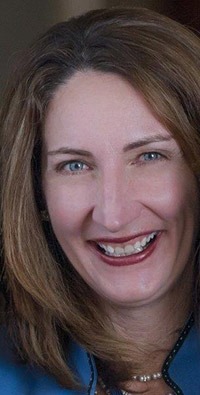
When I hear people in developing countries talk about climate change, it’s often about droughts, famines, increased disease, loss of income, or forced migration. It’s a devastating new reality and it’s clear that those who continue to be hardest hit by the effects of climate change tend to be those who can least afford it.
Former President of Ireland Mary Robinson states, “the fight against climate change is fundamentally about human rights and securing justice for those suffering from its impact.” She speaks of “Climate Justice” and elevates solutions to climate change that put those most vulnerable at the center. I couldn’t agree more.
In addition, many of those on the frontlines of climate change are also the leaders we need for smart and sustainable adaptation and mitigation efforts. Global Washington has amazing members elevating local leaders such as Rise Beyond the Reef, founded by an inspiring couple in Fiji who are listening to local wisdom and creating community around an abundance mindset – one that respects “the connection between land, food, traditional knowledge, identity and innovation.”
And closer to home, the Seattle Foundation is supporting communities of color and low-income populations as those most impacted by climate change in our region. Their focus is on a more human-centered climate response for long-term systems change.
I hope you enjoy the discussions this month and I encourage you to share what you are learning with others so that more people can benefit and be part of this important conversation.

Kristen Dailey
Executive Director
Back to Top
Issue Brief
“Climate Justice” Advances Discussion of Climate Change Risks and Response
By Joanne Lu
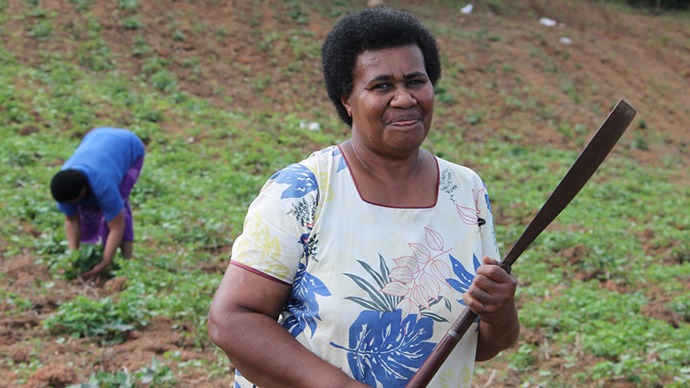
A woman in Fiji cultivates her crops. Photo credit: Rise Beyond the Reef.
On April 22, 1970, 20 million Americans celebrated the first Earth Day as a peaceful demonstration for environmental reform. Fifty years later, it’s now celebrated around the world and has paved the way for efforts like the Environmental Protection Agency, the 1992 United Nations Earth Summit in Rio de Janeiro and the Canopy Project. But these efforts have not been enough, and more than ever, the world is wrestling with the risks and effects of climate change, particularly on the world’s most vulnerable communities.
Last month, in the 50th edition of the World Economic Forum’s annual Global Risks Report, all five of the top risks were environmental, including damage from extreme weather events, the failure of climate-change mitigation and adaptation by governments and businesses, human-made environmental damage and disasters, biodiversity loss and ecosystem collapse, and natural disasters. Although climate change is happening everywhere, research repeatedly shows that those who are already struggling with poverty, oppression and instability are being affected the most and will increasingly bear the consequences. That’s because the injustices associated with poverty, age, gender, social exclusion and weak infrastructure undermine these populations’ ability to cope with climate change.
For example, according to the World Bank, 78 percent of the world’s poor live in rural areas and most of them rely on agriculture for their livelihoods. That means that shifting weather patterns, rising temperatures, extreme weather events like floods and droughts and land degradation are putting the poor at greater risk of losing their livelihoods, being unable to feed their families, sinking further into poverty and maybe even being forced to migrate. By 2030, the World Bank estimates that food prices could be 12 percent higher on average in sub-Saharan Africa because of crop yield losses from climate change. Combined with the other effects of climate change – including increased conflicts and deadly infectious diseases – the World Bank warns that more than 100 million additional people could be living in poverty by 2030, and most of them will be in sub-Saharan Africa and South Asia.
What’s even more unfair is that in many cases, the communities that are most affected are the ones which have contributed the least to climate change. The island nation of Kiribati, for example, is one of the lowest emitters of carbon dioxide in the world. Yet, because of top polluters like the U.S. and China, Kiribati is literally disappearing beneath a rising sea. In 2016, the UN Institute for Environmental and Human Security reported that 94 percent of people living on Kiribati had already been impacted by climate change.
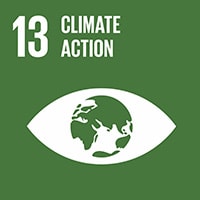 While developing countries are suffering the most from climate change, vulnerable communities in wealthy countries are being disproportionately affected, as well. A federal report published in 2018 concluded that low-income communities and some communities of color, many of which are already overburdened with poor environmental conditions and adverse health conditions, are less resilient to and disproportionately affected by extreme weather and climate events, including the health impacts. In Washington state, for example, Seattle Foundation says that “46 percent of all toxic sites are in areas mostly populated by people of color, while 56 percent are in largely low-income areas.” These communities, therefore, are struggling with contaminated drinking water, poor air quality, unhealthy housing and extreme weather events. Because of discriminatory zoning, banking and employment practices, people in these communities also have the least access to tools that would help them cope, such as transportation, education, insurance and healthy housing.
While developing countries are suffering the most from climate change, vulnerable communities in wealthy countries are being disproportionately affected, as well. A federal report published in 2018 concluded that low-income communities and some communities of color, many of which are already overburdened with poor environmental conditions and adverse health conditions, are less resilient to and disproportionately affected by extreme weather and climate events, including the health impacts. In Washington state, for example, Seattle Foundation says that “46 percent of all toxic sites are in areas mostly populated by people of color, while 56 percent are in largely low-income areas.” These communities, therefore, are struggling with contaminated drinking water, poor air quality, unhealthy housing and extreme weather events. Because of discriminatory zoning, banking and employment practices, people in these communities also have the least access to tools that would help them cope, such as transportation, education, insurance and healthy housing.
The federal report also attributes part of the problem to the fact that these vulnerable populations are often excluded in planning processes. That’s why the Seattle Foundation launched its Climate Justice Impact Strategy to ensure that communities of color and low-income communities are “leading and shaping efforts to reduce the disproportionate effects of climate change that they experience.”
World Vision also works closely with communities around the world to identify solutions that work for their individual contexts. In Ethiopia, for example, World Vision wanted to address the health problems, carbon emissions and deforestation associated with open cooking fires. So, they worked with women to determine what kind of fuel-efficient and environmentally friendly cookstoves worked best for their needs, and they have since distributed tens of thousands of them across the country.
In India, Earthworm is also helping smallholder farmers become more resilient in the face of climate change by helping them nurture the country’s soil back to health. The Mitti Bole program (or Soil Speaks) brings together international soil experts, Indian organic farming pioneers and other researchers to educate farmers on responsible soil and water management, agroforestry to improve soil quality and sequester carbon as well as ways to reduce their pesticide and fertilizer dependence.
Experts are recognizing, too, that any effective response to climate change must take gender into account, because women and girls are disproportionately affected. Part of this is because 70 percent of the world’s poor are women and girls, but also societal roles, gender-specific health concerns and discrimination play a big part. For example, when Cyclone Idai hit Mozambique, Malawi and Zimbabwe last year, 75,000 pregnant women were affected, with 7,000 at risk of “life-threatening complications” because the flooding and destruction obstructed access to clean water, sanitation and reproductive health care. Domestic work and caregiving duties – women and girls’ primary responsibilities in many contexts – also become much more difficult and time-consuming with climate change. And if they are displaced from their homes by an extreme weather event, they face a greater risk of exploitation and sexual violence.
But women and girls have a crucial role in climate change adaptation and mitigation. That’s why Project Drawdown, a repository for substantive solutions to climate change, focuses to a large extent on women and girls, including girls’ education. Education, they say, “lays a foundation for vibrant lives for girls and women, their families, and their communities,” but it also helps curb carbon emissions because women with more education tend to have fewer and healthier children. Education can also help girls and women become more productive and responsible food providers with a greater capacity to cope with climate shocks.
Remote Energy is also helping more women get involved in climate solutions in a technical capacity. Their program equips women in developing countries with the technical skills and a community of support to become solar electric technicians. This not only opens up economic opportunities for women, but also gives them a greater voice in decisions about energy within their communities. After all, in developing countries, women are the main users of household energy, so training them in renewable technologies makes their work more sustainable and efficient, which also gives them more time to pursue education and income-earning activities.
All of these programs illustrate the core principles of climate justice as laid out by the Mary Robinson Foundation. We must remember that climate change is not just an environmental or physical problem; it also contains ethical and political dimensions.
The core principles of climate justice are as follows: 1) respect and protect human rights 2) support the right to development 3) share benefits and burdens equitably 4) ensure that decisions on climate change are participatory, transparent and accountable 5) highlight gender equality and equity 6) harness the transformative power of education for climate stewardship and 7) use effective partnerships to secure climate justice.
These principles are not new, the foundation says, but should help those in pursuit of climate justice achieve a human-centered approach – one that shares the burdens, benefits (wealth from emissions, for example) and responsibility for solving climate change fairly and equitably, and, perhaps most importantly, protects the rights of the most vulnerable.
# # #
The following Global Washington members are working to address climate change and its impacts on the most vulnerable communities around the world.
Earthworm
Earthworm Foundation (formerly known as The Forest Trust) has 20 years of experience in finding solutions to the major social and environmental problems that our world is facing today. Earthworm’s vision is for future generations to not simply survive, but to thrive. The nonprofit seeks to build a world where the balance between people and the environment, value and profit, people’s beliefs and actions is maintained and where human, natural and capital resources become a force for good. For that, Earthworm sees a world where forests are a boundless source of materials and a home for biodiversity; communities see their rights respected and have opportunities to develop; workers are seen as productive partners; and agriculture becomes the instrument to feed a hungry planet and keep our climate stable.
FSC Investments & Partnerships
Forest Stewardship Council Investments & Partnerships (FSC I&P) is the Seattle-based branch of FSC. As the original pioneers of forest certification, FSC has over 25 years of experience in sustainable forest management. FSC promotes the responsible management of the world’s forests, and has developed a high standard of forest management that prioritizes the environmental, social and economic rights of community foresters, and indigenous people around the world. FSC I&P’s mission is aligned with the FSC in promoting environmentally appropriate, socially beneficial, and economically viable management of the world’s forests. In 2018, FSC launched its Ecosystem Services Procedure, which allows businesses and governments an additional mechanism to demonstrate the impact of their products and investments on watershed services, carbon sequestration and storage, and biodiversity conversation, among other ecosystem services. Recently, FSC Canada received funds from the Canadian Ministry of Environment and Climate Change to support implementing the new Canadian National Forest Standard, the result of five years of rigorous consultation with indigenous groups, environmental and social stakeholders, and industry actors. It addresses the most pressing issues facing Canadian forests, including preserving the threatened woodland caribou, Indigenous people’s rights, worker’s rights, including gender equity, and landscape management and conservation.
Future of Fish
Future of Fish works to ensure sustainable livelihoods for fishing communities and long-term health of wild fish populations, which billions of people depend upon as a critical source of protein. Climate change is already wreaking havoc for coastal communities in developing countries, with rising seas damaging dockside infrastructure and warming waters driving away traditional fish stocks. The result is loss of income, food, and in many cases, cultural heritage. Future of Fish collaborates with small-scale fishers to design better systems, practices, and technologies that help fishers continue supporting their communities in a time of unstable climate impacts. Climate justice is only possible when front-line communities have the resources they need to survive and thrive. Future of Fish works closely with fishers, seafood supply chains, and the local community and governments to co-design interventions that build environmentally sustainable, climate resilient, and economically viable fisheries. With support from global and regional partners, Future of Fish helps address food security and achieve long-term social and environmental impact for coastal fishing communities around the world.
Heifer International
Heifer International is on a mission to end global hunger and poverty in a sustainable way. For over 75 years, the organization has invested alongside more than 35 million farmers and business owners around the world, supporting them to build businesses that deliver living incomes and protect the environment. Heifer works with smallholder farmers using a tried and tested community development model, providing farming inputs that enable them to grow their businesses using locally available resources. Expert teams and partners provide training in climate smart agriculture techniques so farmers can increase their resilience to climate change, improve production, restore soil health and reduce deforestation. Many of the communities Heifer works with are among the most vulnerable to climate change. Heifer works with them to manage grazing, protecting areas of important biodiversity, enabling farmers to make a living income and restore resources for future generations. Heifer also invests alongside farmers in clean, green energy solutions, like solar power systems and biogas, so they can generate the energy they need to power their continued growth. Heifer believes local farmers hold the key to feeding the world, and it is working with them to make their farms sustainable in every sense of the word.
Human Rights Watch
Human Rights Watch conducts on-the-ground research to document the impact of climate change and climate-harming activities and to advocate for positive change locally, nationally, and internationally. We disseminate our findings through our global media network and 11 million social media followers. We use our findings and media exposure to urge governments and corporations to implement rights-respecting environmental policies and practices, with a focus on the disadvantaged populations that are suffering harms most acutely. In coalition with other environmental and human rights groups, we successfully advocated for the inclusion of human rights language in the landmark 2015 Paris Agreement on Climate Change. In the coming year Human Rights Watch’s work on climate change will focus on two of today’s most urgent issues: protecting forests that serve as critical “carbon sinks” and accelerating a global shift away from the use of coal, one of the dirtiest fossil fuels. We will undertake research and advocacy on issues including food insecurity for Indigenous communities in Canada and the ways in which climate-harming activities, like coal emissions in Europe and Africa and deforestation in South America, also harm human rights.
Mercy Corps
The climate crisis is creating unprecedented challenges for millions of people already burdened by poverty and oppression. Mercy Corps’ climate resilience work tackles the human impacts of climate change—particularly disappearing livelihoods, rising food insecurity, increasing disaster, and escalating violence—by empowering communities to adapt, innovate and thrive. Mercy Corps tackles the root causes of instability, empowering people to survive crisis and transform their communities. As climate change is a key driver of events such as floods and droughts that undermine development gains and threaten vulnerable people, Mercy Corps partners with local communities to rebound from disasters while helping them be more prepared for the next ones. In Mali, Mercy Corps partnered with local communities, through a cash for work program, to construct dams along the Niger river to secure communities against flooding and conserve water for off-season farming. As a result, for the first time in 30 years, 250 families in the Tassakane village of the Timbuktu region didn’t suffer from flooding during the rainy season
Microsoft
Microsoft’s mission is to empower every person and organization on the planet to achieve more. This includes working with enterprise customers as well as non-profits and NGOs around the world to scale the impact of their work. Microsoft is empowering first responder organizations to meet critical global needs, humanitarian organizations to drive greater impact, and displaced people to rebuild their lives with a mix of technology, cash grants, employee donations and staff time. This mission-driven work is evident in its environmental work, which began in 2012 as a carbon neutral company. In responding to the urgency of climate change, Microsoft recently made three commitments: 1) the company will become carbon negative by 2030; 2) it will take responsibility for removing its historical carbon emissions by 2050; and 3) it will invest $1 billion over the next four years into new technologies and expanded access to capital for those working around the world to solve climate change.
National Wildlife Federation
As the U.S. confronts the cascading impacts of a changing climate, advancing environmental justice must be central to reducing greenhouse gas emissions, boosting resilience, and revitalizing communities. Low-income and communities of color are disproportionately impacted by the effects of a changing climate—and the National Wildlife Federation has a responsibility to empower frontline communities to enact transformative change by providing resources and tools. To achieve this vision, for both people and wildlife, NWF is working to ensure that equity and the principles of environmental justice are institutionalized into its climate work. One way is through Revitalizing Vulnerable Communities Institute, which is empowering communities to implement holistic solutions to environmental and economic issues. The Federation is also undertaking a Climate and Communities Project that works to help communities heavily dependent on fossil fuels feel more prepared for, and engaged with, national climate policies. Here in the Pacific Northwest, the National Wildlife Federation is engaged in climate change issues unfolding in the Columbia River basin and the Snake River. Hotter water temperatures are pushing cold water fish—including salmon—toward extinction, greatly impacting the inland and coastal Native American communities, and as well as rural fishing communities that depend on them.
Oxfam America
Oxfam America believes that the injustice of climate change is also the injustice of inequality – those who have done the least to contribute to global emissions are the hardest hit. Climate justice requires that we rapidly shift towards low-emissions economies that leaves no one behind, and promote resilient development by building capacities and leadership of communities & womenon the frontlines. The climate crisis is already impacting the world – wildfires in Australia, locusts in Africa, and communities in the global south are often the hardest hit with extreme weather events like droughts and floods taking a heavy toll. Oxfam’s vision and value add in the fight for climate justice centers these communities unlike other organizations that focus on wildlife preservation or more narrowly on environmental impacts. Through its work, Oxfam is committed to reducing climate change by tackling the structural drivers of the crisis often rooted in unequal economic models, which requires holding governments and big business accountable. Oxfam works with a range of partners to help communities adapt and become more resilient, and are committed to elevating the voices and leadership of communities – especially women who are on the frontlines. Oxfam also believes that policy and advocacy have key roles to play to advance climate justice. Oxfam works to defend the Paris agreement and engage the US government to push for a robust global framework to tackle the climate crisis. Oxfam engages food and beverage companies to tackle the hidden emissions in their supply chains; advocates with international finance institutions to channel more investment towards pro-poor clean energy; works toward greater transparency in the oil and gas sector; and encourages governments to invest in the rights and livelihoods of small famers, especially women farmers.
Remote Energy
Remote Energy (RE) believes that access to reliable sources of sustainable energy is a fundamental requirement for the advancement of education, healthcare, economic opportunity and quality of life. It is also a critical step in mitigating the effects of climate change. The climate crises has fostered significant growth in the solar energy industry worldwide, and has fueled the fast growing need for a trained solar workforce. RE has responded by developing and implementing regionally appropriate, customized technical capacity building programs and developing hands-on, practical learning opportunities for solar technicians and instructors in marginalized communities worldwide. RE’s scalable programs, methodology and mentorship opportunities provide the knowledge, technical skills and support network for inspiring people and communities to move towards energy independence and sustainable development. RE is also committed to gender equality and supports the belief that women’s talents and leadership are vital to maintain a diverse, sustainable PV industry and critical in the fight against climate change. RE’s Women’s Program is designed to develop women decision-makers, end-users, technicians, and educators and offers customized, women’s-only courses and mentoring opportunities with professional female instructors.
Rise Beyond the Reef
Rise Beyond the Reef bridges the divide between remote communities, government and the private sector in the South Pacific, sustainably creating a better world for women and children. There is no reason not to value the inherent intelligence and resilient nature of Pacific Island cultures that have self-sustained for thousands of years. Rise Beyond the Reef believes that if leadership in remote communities can be cultivated and strengthened, if these fire-keepers of traditional knowledge can have a place where they are protected, ignited and supported to grow sustainably in the 21st century, if women have an equal voice that’s heard and respected in their communities, if their experiences and insights are valued, if children’s rights are protected, then the entire community will rise. It’s not about helping the poor or just focusing on the environment, it’s about creating value around the important role remote communities play in our world’s whole picture, including creating a stable climate. It’s about valuing rather than extracting. It’s about supporting rather than directing. It’s about seeing our collective future. That’s when we all rise together.
Seattle Foundation
Seattle Foundation ignites powerful, rewarding philanthropy to make Greater Seattle a stronger, more vibrant community for all. As a community foundation, it works to advance equity, shared prosperity, and belonging throughout the region while strengthening the impact of the philanthropists they serve. Founded in 1946 and with more than $1.1 billion in assets, the Foundation pursues its mission with a combination of deep community insight, civic leadership, philanthropic advising and judicious financial stewardship. The Climate Justice Impact Strategy is Seattle Foundation’s comprehensive approach to ensuring that communities of color and low-income communities are leading and shaping efforts to reduce the effects of climate change, which they experience disproportionately. To reduce the risks of climate change, we address its root causes, identify and adapt to its impacts, and strengthen community resiliency to those impacts. Justice and equity are at the core of this approach, which uses community-based research while building diverse coalitions and increasing the capacity of nonprofits to advance local solutions to this global challenge.
Snow Leopard Trust
The Snow Leopard Trust (SLT) seeks climate justice through its mission to protect snow leopards in partnership with local communities that share the cat’s habitat. For nearly four decades, SLT has worked to empower herding families across Asia to take action for their local ecosystems and secure a prosperous future for both humans and wildlife. With programs and staff in five countries in Asia and support from around the world, SLT coordinates programs that promote sustainable development, green livelihoods, and climate-smart planning, including environmental education camps, livestock insurance and vaccination programs, ranger trainings, and a handicraft program called Snow Leopard Enterprises. Using approaches from both natural and social sciences, SLT researchers endeavor to understand the complex dynamics between people, predators, and the environment. SLT has been a key partner in the Global Snow Leopard & Ecosystem Protection Program (GSLEP) and rallied the governments of 12 countries to support programs that link conservation with sustainable development. As humankind expands its reach to the most remote areas of snow leopard habitat, SLT strives for climate justice through community involvement and multilateral partnerships.
Tearfund USA
In 1992, Tearfund became the first large international development NGO to focus on the climate crisis after seeing how it affected the organization’s partners across the globe. The rate and impact of environmental degradation are hitting people living in poverty the hardest – the very people who have done the least to cause it. To combat this issue, Tearfund supports communities with programs related to waste management, renewable energy, climate-smart agriculture, and climate resilience. Through Tearfund’s training and equipping programs, vulnerable communities are able to produce enough food for everybody using environmentally responsible farming methods. This way they become part of a sustainable future. Tearfund also calls on governments and companies to change harmful practices that contribute to climate problems. Currently, Tearfund is working in more than 24 countries to address the challenges caused by the climate crisis, furthering its efforts in advocacy, campaigning, and supporting environmental sustainability programs.
Vulcan
To address climate change Vulcan philanthropy funds projects and investments in research, innovation, and policy change. One innovative project for example is improving researchers’ ability to understand sea ice in response to climate change. Through the Foundation and personal philanthropy, Paul G. Allen and Vulcan have provided more than $50 million for forest preservation, research, education, development and management, protecting key land and habitats in the Pacific Northwest and around the world. In addition, Vulcan Production films, such as Racing Extinction and Pandora’s Promise help audiences understand the effects of climate change and spark a dialogue about solutions. On the policy front, Paul G. Allen and the Paul G. Allen Family Foundation joined a lawsuit to require the U.S. Department of the Interior’s Bureau of Land Management to prepare a programmatic environmental impact statement for the federal coal leasing program. In a blog post, Allen said “It is time for our government leaders to make informed decisions on how to best manage our public resources to meet our nation’s energy needs.”
Woodland Park Zoo
More than a million vulnerable species need humans to take action for their survival. Meaningful reductions in carbon emissions to avert the worst impacts of the climate crisis require behavioral, organizational and policy change. Woodland Park Zoo has joined The Wave, a coalition of more than 100 Pacific Northwest organizations pledged to fight for 100% clean energy, zero waste, and clean air and water for every living creature. Through exceptional animal care and sustainable practices such as solar panels, eliminating single-use plastics, investing in green infrastructure, and converting our animals’ waste into ZooDoo compost – Woodland Park Zoo continues to inspire our community and nearly one million unique visitors a year to make conservation, and sustainability, a priority in their lives.
World Vision
World Vision is a Christian humanitarian organization dedicated to working with children, families, and their communities worldwide to reach their full potential by tackling the root causes of poverty and injustice. World Vision works directly with communities to identify context-specific solutions with a focus on food security, clean energy, natural resources management and climate adaptation and mitigation. Projects include interventions like reforestation, agro-forestry, climate-smart agriculture, clean energy and access to carbon markets. World Vision Australia is also a world leader in promoting Farmer Managed Natural Regeneration (FMNR) in rural communities, a process that naturally regenerates trees on farmland and forest areas to improve agricultural productivity and reduce the incidence of droughts, floods and landslides. A number of communities in Ethiopia have also benefited from the Clean Stoves Project, which reduces the health risks associated with smoky open fire stoves, and reduces the need to cut down trees. Finally, World Vision has worked with communities in South East Asia and the Pacific region to better prepare them for tropical storms and other natural disasters, which are becoming increasingly frequent and violent as a result of climate change.
Back to Top
Organization Profile
Local Philanthropic Institution, Seattle Foundation, Has Begun a New Chapter Addressing Climate Justice
By Stephanie Stinson

2017 Earth Day climate march in Seattle. Photo credit: Rick Theis, Twenty20.
Community foundations first emerged as U.S. institutions more than 100 years ago. Since then they have become essential bridge builders, civic leaders, and philanthropic catalyzers in the places they serve.
Closer to home, the name Seattle Foundation has long been synonymous with efforts to strengthen the health and vitality of our region through philanthropy since its creation in 1946. Each philanthropic strategy designed by Seattle Foundation is rooted in the belief that all individuals, families, and communities deserve opportunities to thrive, regardless of their race, place, or other identity. In line with its tradition as a recognized leader in striving to reduce the inequities that exist across our local communities, Seattle Foundation launched a Climate Justice Impact Strategy in 2018 to guide the evolution of its ongoing commitment to this work.
Part of a broader Community Program practice area, the Climate Justice Impact Strategy endeavors to address the disproportionate impacts of climate change on communities of color and low-income communities, while also ensuring these communities themselves are at the frontline in designing initiatives to address a changing climate. The strategy document states: “Everyone has a stake in achieving climate justice and we believe that focusing on those first and worst impacted ensures that we all thrive.”
Sally Gillis, the managing director of strategic impact and partnerships at Seattle Foundation, oversees the Climate Justice Impact Strategy. Drafted with an eye towards long-term systems change, Gillis said that the strategy recognizes the importance of concurrent efforts around mitigation, adaptation resilience and leadership.
After launching its climate justice strategy, the Seattle Foundation undertook its first major action in this area – the endorsement and support of Washington state Initiative 1631, a carbon emissions fee. “This for us was a strong step forward in speaking to our commitment, using our voice as a civic leader in support of equitable climate change policies that truly support frontline and marginalized communities,” said Gillis. “We continue to see policy as a critical lever. While the initiative wasn’t successful, I’m proud that we stood on the right side of history in speaking to our values.”
When asked what particular policies Seattle Foundation anticipates supporting in 2020, Gillis commented that the organization will be keeping an eye on what unfolds during this legislative cycle to then inform future ballot priorities. She also noted that Seattle Foundation relies on its community partners to elevate ways the organization can be most valuable.
“There is great effort through many of our grantees to put progressive policies on the ballot and in front of the legislature, recognizing that if we don’t act quickly, climate justice is going to be harder and harder to be realized.”
A fundamental component to the strategy’s approach includes producing more prominent messaging around the human-centered impacts that communities of color and low-income communities face in a changing climate. It is widely documented that in the United States, race is the most significant predictor of a person living near contaminated water, air, or soil. Locally, this is evidenced by the fact that 58 percent of the population that lives within one mile of the Duwamish River Superfund boundary are people of color. To this end, Seattle Foundation is using storytelling to better illuminate the complexity and humanity of climate justice.
Last August Seattle Foundation invited 20 philanthropists to join Puget Soundkeeper and Duwamish River Cleanup Coalition on a boat tour of the Duwamish River. This gave philanthropists the opportunity to reflect on both the social and environmental consequences of a century of development in Seattle’s commercial district and how they wanted to be part of solutions moving forward.
“We know not everyone is able to take time out of their day to join us,” Gillis acknowledged. “Therefore, I’m excited in 2020 to think about how we might use vlogs (video blogs) and video to capture the stories of our grantees, and truly tell of their resilience and leadership through this work. We need to shift the storyteller to on-the-ground leaders who are holding and centering community.”
A key aspiration of the outing was to bring more overall attention to human-centered impacts within the broader climate change narrative.
“Our neighbors along the Duwamish River will experience climate change through sea level rise, storm surges, flooding, and this will amplify the community’s current and urgent need to take action,” stressed Gillis. “At the same time, that community is seeing increased gentrification and decreased affordability, so that local residents don’t just face climate change, but they face affordability changes. We must intentionally plan and protect communities so that they aren’t forced to make false choices between sea walls and affordable housing, both of which are necessary for a community to thrive in place.”
Gillis noted that these same choices, between livability and safety, are made by communities in many of the places that Global Washington members work around the world. Such circumstances are heightened by extreme inequality and a lack of government accountability.
In describing the foundation’s programmatic goals for the coming year, Gillis said they will continue to work in partnership with institutional funders, while concurrently working across silos to ensure that highly impacted communities are given the space to lead.
“We recognize that within the environmental field, especially in the Pacific Northwest, has been historically white-led and male-dominated. We know that in order to ensure that climate justice is realized, we have to expand the movement, reinforcing People-of-Color-led leadership within the field,” said Gillis.
Pursuant of these leadership objectives, in December Seattle Foundation invested $500,000 in ten frontline organizations undertaking community-based and community-defined efforts. Gillis said that she looks forward to evolving similar work as a key priority in 2020.
Gillis cites honest feedback and fostering authentic partnership with these frontline organizations as being among the biggest lessons learned since the foundation adopted this strategy.
“As part of our grant making and convening efforts, we have been a long-time funder of Front and Centered, a collaborative of 60 plus POC-serving organizations, fighting for environmental justice. This has brought us into honest dialogue with those organizations who have called us into conversations and who have pushed us to be better than philanthropy has been historically,” said Gillis.
Finally, Gillis noted the importance of connecting Seattle Foundation’s local efforts to the broader climate justice initiatives taking place worldwide.
“As we approach climate justice, we could work in our local Pacific Northwest context. At the same time we are aware that we can’t work in isolation. For example, we know that the burning forests of Australia will impact our air quality here in Seattle. Ultimately, we are sharing one planet and one set of solutions. Thus, we continually seek out opportunities to learn from national and international leaders to help inform our locally-led solutions.”
Global Washington works in partnership with Seattle Foundation to promote climate justice as a priority issue locally and globally. For more information about how you can support Seattle Foundation’s work in the area of climate justice, contact Sally Gillis.
Back to Top
Goalmaker
Love (and Abundance) in the Age of Climate Change
By Amber Cortes
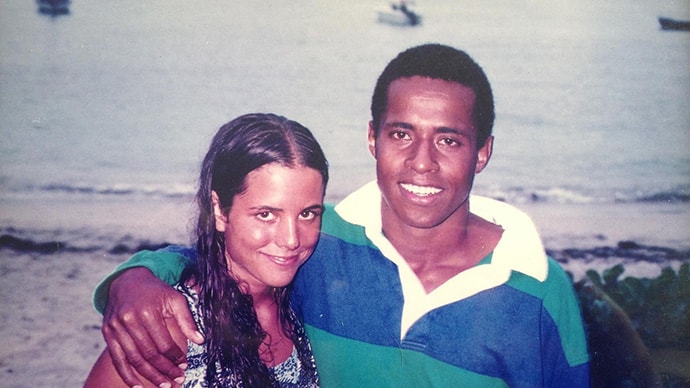
Janet and Semi Lotawa in Fiji. Photo provided by Janet Lotawa.
The climate is already changing, and it’s getting urgent.
You could look at it this way—there is scarcity, there is instability, there is crisis. There is inequality, there are ‘the haves’ and the ‘have nots.’
Or you could see it another way entirely—that there are solutions right in front of us, if we can just listen. There is abundance in community. There is resilience in wisdom. There’s empowerment and innovation when people come together for the greater good.
It’s a way of thinking that originally brought Janet and Semi Lotawa together in the remote Fijian village where they met, and it’s what has sustained their relationship for the past 25 years. It’s also a guiding principle behind the work that they do running Global Washington network member organization Rise Beyond the Reef.
While in high school, Janet and her family went to Fiji for a vacation. There, Janet says, she was struck by a gut-level feeling of finding something she never knew she was even missing, “that special place that’s been existing in your head, that you never think actually exists on the planet, too.”
The missing piece Janet had been craving was a sense of community.
“I think it’s the just immeasurable side of being in a community and what it brings to you. And what that environment can create—that’s what was so intriguing to me.”
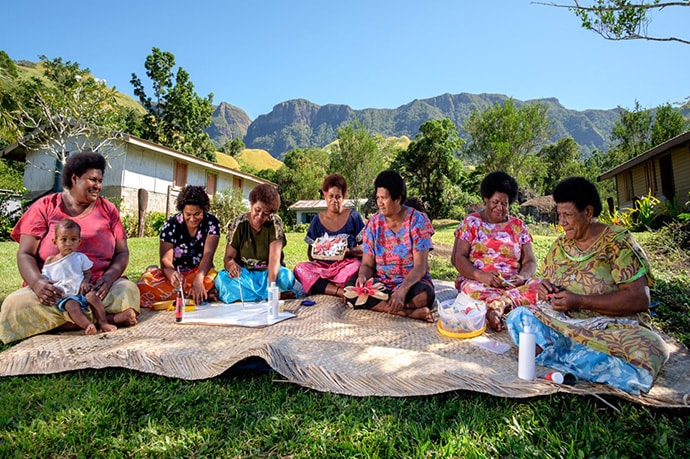
Women in Fiji creating traditional crafts. Photo credit: Rise Beyond the Reef
Janet spent the next summer volunteering in a Fijian community on a learning program, which was where she met Semi, who had just finished forestry school and was a conservation leader in the program.
“And it was not really anything but in the back of my mind,” Semi said, “because I knew two weeks later, they will leave and go back to the US. But, you know, right after that, we kept in touch.”
And they did so by writing letters, since Semi lived a rural and remote coastal community on the Fijian Island of Viti Levu.
“Being in the village, you don’t have a designated post office, so it has to be a care of somebody,” Semi explained. “So, a month later, ‘oh, hey, I think you have a letter from somewhere!’ From Janet, who must be eagerly waiting on the other end to receive a reply!”
Semi came to the States to visit Janet in 1998, Janet recalls, and the rest was history:
“It wasn’t planned that he was going to stay. But he did! And we decided to get married, instead of going back and forth for years. So, we eloped!”
The two spent the next decade in the States while Semi, who had worked in sustainable development, pivoted towards a business degree—”because aid is great,” he explained, “but it is at some level also what makes people handicapped; it keeps their hands out.”
Growing up in Fiji, Semi had seen his fair share of NGOs and donors coming in “with their own money, agenda, and frameworks.” But their frameworks often felt foreign to the local communities there, who were the resource owners (82% of land in Fiji is Indigenous-owned), and had their own way of doing things.
“One thing was obvious—that when the funding timeline was over, nothing was sustainable! As far as transformational changes in the community, nothing would stick.”
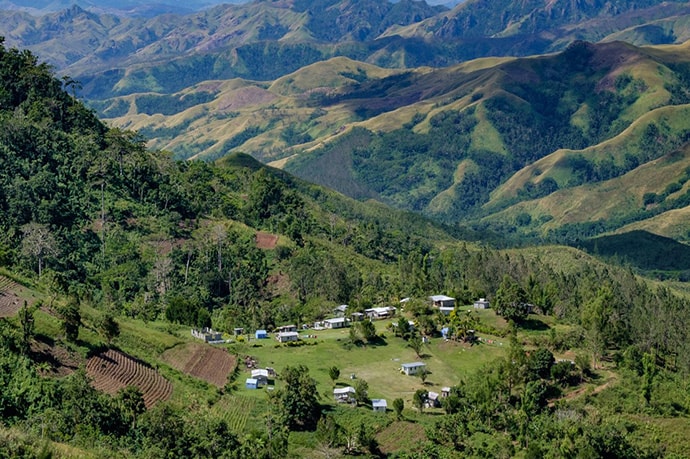
Remote village in Fiji. Photo credit: Rise Beyond the Reef
Janet agreed, adding that the “rigidness of the lens that’s providing the funding support creates a missed opportunity really to learn from indigenous communities.”
That’s why the Lotawa’s approach for Rise Beyond the Reef, which works towards economic empowerment of women in rural remote Pacific coast communities, revolves around aligning with culture first. They start with a baseline process of listening to the community.
For example, when women said they wanted to earn their own income, it resulted in a partnership approach between Rise Beyond the Reef and 350 women in 23 rural communities to create a community-centered supply chain that sends community-made, locally-sourced artisanal goods to market.
“Way before FedEx,” Semi says, “we had our own ways of moving product across those mountains. And so, when we started this program, we never really reinvented a new way of moving product. But it’s because we understand the social current; the traditional way we exchange goods.”
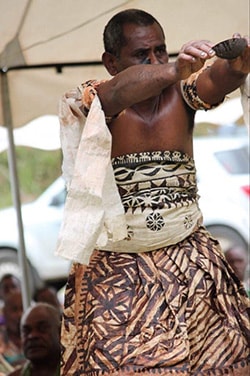
Photo credit: Rise Beyond the Reef
Rise Beyond the Reef’s other programs include an education leadership training program to help men address gender-based violence in their communities, and an indigenous tree species replanting initiative.
“I think a lot of our work is around trying to help what we call the total abundance structure,” says Janet. It’s a mindset rooted in community and self-sustaining resiliency.
“In Fijian culture, they call it solesolevaki. So, it’s working together for the greater good beyond just one individual person. And that sort of philosophy is carried through a lot of the community structure,” Janet explains.
It’s the spirit of solesolevaki, Semi says, that informs and nourishes Rise Beyond the Reef’s community development framework.
What’s at stake in the global climate crisis, Janet and Semi insist, is this total abundance mindset—”the connection between land, food, traditional knowledge, identity and innovation.”
Instead, the global development world operates on a scarcity mindset, Semi says, with siloed strategies and projects becoming “exhausting rather than sustaining,” and promoting a victim mentality.
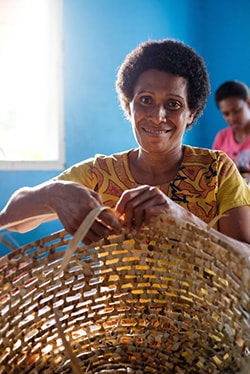
Fijian woman weaving a basket. Photo credit: Rise Beyond the Reef
“What we’ve seen is that the areas that have had the highest rates of interaction with the aid sector are the ones that see themselves as the greatest victims,” Janet explained.
When it comes to adaptation and mitigation, Fijians, like others faced with the complexities of climate effects, are not victims – but agents of change with solutions of their own. And the role of organizations like Rise Beyond the Reef is to give them a boost.
“Infusing opportunities and resources to help communities continue to create their own version of change and own the thing that they’ve created. And that’s where you get the beauty, right?” says Janet.
And driven by its creators, an “abundance mindset,” Janet says, can produce the most lasting change.
“And it’s something that’s, you know, I joke, it’s climatized, right? Like, it’s going to last, it’s going to survive in that environment. And that’s really the key to sustainable development—just that ability to create something in balance.”
Global Washington members can help support Rise Beyond the Reef by ordering some of their handcrafted, community-made gifts—just in time for Valentine’s Day! Their new product line comes out this month.
Back to Top
From Our Blog
Tearfund USA, a Faith-based International NGO, Seeks to Inspire Christians to Act on Climate
by Amanda Miah, Content Manager of Tearfund USA
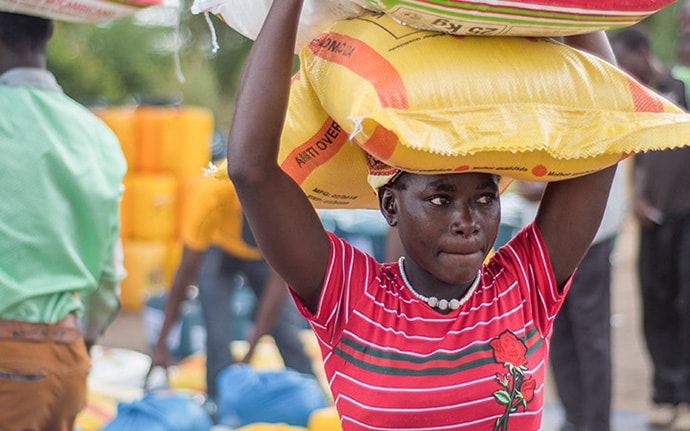
Approximately 45 million people across 16 countries in southern Africa are facing severe food shortages due to a devastating combination of extreme weather events and political and economic instability. Photo credit: Tearfund USA
Last September, the world witnessed an unprecedented movement of young people raising their voices, demanding that their leaders take action on the global climate crisis. For millions of people across the world, standing up for climate justice isn’t just a passing trend; it is both urgent and necessary for a flourishing future.
Tearfund, a faith-based international aid and development organization, is among those taking action. We have seen firsthand how climate change is affecting those we serve. The problems produced by an unstable climate are undeniable and as a result, vulnerable people are being pushed back into poverty at an alarming rate.
Read More
Back to Top
Welcome New Members
Please welcome our newest Global Washington members. Take a moment to familiarize yourself with their work and consider opportunities for support and collaboration!
Hope for Life
Hope For Life serves impoverished youth through holistic care. It provides stability and empowers the communities they serve with resources and education needed to obtain a flourishing future. hopeforlife.us
Manos Unidas International
Manos Unidas International provides professional development training, program support and financial support for organizations serving children and youth in Latin America. manosunidasperu.org
Back to Top
Member Events
February 8 – 9: Asian Art Museum – Housewarming: Free Reopening Weekend
February 8: The Foundation for International Understanding Through Students (FIUTS) – CultureFest Performance Showcase 2020
February 13: GSBA, Washington State’s LGBTQ & Allied Chamber of Commerce – Thrive Together: 39th Annual GSBA Business & Humanitarian Awards Dinner
February 13: The Henry M. Jackson School of International Studies – Destination Europe!
Check out other upcoming events in our Community Calendar.
Back to Top
Career Center
Research and Impact Officer, Global Partnerships
Senior Philanthropy and Major Gifts Officer, Landesa
Senior Manager, Strategic Initiatives, Malaria No More
Check out the GlobalWA Job Board for the latest openings.
Back to Top
Tearfund USA, a faith-based international NGO, seeks to inspire Christians to act on climate
Posted on February 6, 2020.
by Amanda Miah, Content Manager of Tearfund USA

Approximately 45 million people across 16 countries in southern Africa are facing severe food shortages due to a devastating combination of extreme weather events and political and economic instability. Photo credit: Tearfund USA
Last September, the world witnessed an unprecedented movement of young people raising their voices, demanding that their leaders take action on the global climate crisis. For millions of people across the world, standing up for climate justice isn’t just a passing trend; it is both urgent and necessary for a flourishing future.
Tearfund, a faith-based international aid and development organization, is among those taking action. We have seen firsthand how climate change is affecting those we serve. The problems produced by an unstable climate are undeniable and as a result, vulnerable people are being pushed back into poverty at an alarming rate.
Continue Reading
PRESS RELEASE: Bill & Melinda Gates Foundation Commits $10 Million to Global Response to 2019-nCOV
Posted on January 27, 2020.
SEATTLE – January 26, 2020 – The Bill & Melinda Gates Foundation today announced that it is immediately committing $10 million in emergency funds and corresponding technical support to help frontline responders in China and Africa accelerate their efforts to contain the global spread of 2019-nCoV.
The foundation is committing $5 million to the 2019-nCoV response in China and is already working with a range of Chinese public and private sector partners to accelerate national and international cooperation in areas of critical need, including efforts to identify and confirm cases, safely isolate and care for patients and accelerate the development of treatments and vaccines.
Partners include the Chinese Center for Disease Control and Prevention, the National Natural Science Foundation of China and various research institutes affiliated with the Chinese Academy of Sciences, Xiamen University and Sinopharm China National Biotec Group.
The foundation is also immediately committing $5 million to assist the Africa Centers for Disease Control and Prevention in scaling up public health measures against 2019-nCoV among African Union member states. These measures will include technical support to implement the screening and treatment of suspected cases, laboratory confirmation of 2019-nCoV diagnoses and the safe isolation and care of identified cases.
About the Bill & Melinda Gates Foundation
Guided by the belief that every life has equal value, the Bill & Melinda Gates Foundation works to help all people lead healthy, productive lives. In developing countries, it focuses on improving people’s health and giving them the chance to lift themselves out of hunger and extreme poverty. In the United States, it seeks to ensure that all people—especially those with the fewest resources—have access to the opportunities they need to succeed in school and life. Based in Seattle, Washington, the foundation is led by CEO Sue Desmond-Hellmann and Co-chair William H. Gates Sr., under the direction of Bill and Melinda Gates and Warren Buffett.
GEEKWIRE: Microsoft pledges to be ‘carbon negative’ by 2030, launches $1B Climate Innovation Fund
Posted on January 16, 2020.
BY TODD BISHOP
January 16, 2020
REDMOND, Wash. — Microsoft says it will be carbon negative by 2030, removing more carbon from the environment than it emits each year, and will remove enough carbon by 2050 to make up for all of its emissions and electrical consumption since its founding decades ago.
In addition, the company will launch a $1 billion Climate Innovation Fund designed to encourage the development of new carbon reduction and removal technologies.
Microsoft CEO Satya Nadella made the pledge Thursday morning during an event at the company’s Redmond headquarters, detailing a sweeping new plan to eliminate Microsoft’s environmental impact and also give its partners and customers new tools to address theirs.
Read the full article on Geekwire.
FORBES: Can Bicycles Relieve Poverty? World Bicycle Relief Says Yes
Posted on January 14, 2020.
Jim Vinoski
My visit last summer with the great folks at SRAM, the bicycle parts makers headquartered in Chicago, was valuable in many ways. One of my most rewarding lessons during the trip was the introduction I received to World Bicycle Relief (WBR), an organization co-founded by one of the co-founders of SRAM. The two share office space there in the Windy City.
“It’s hard for those of us in developed nations to realize what a difference a bicycle can make,” said Dave Neiswander, CEO of WBR. “It’s an important tool – it can mean a mother getting her sick child to a clinic, or a farmer getting his produce to market before it spoils. For students who have to travel 10 or 20 miles each way to school, it can change their opportunities. For girls especially, it can change their bargaining power. A bicycle will be one of the most valuable, if not the most valuable, possessions for that household.”
Continue reading the article at Forbes.com
January 2020 Newsletter
Posted on January 9, 2020.
Welcome to the January 2020 issue of the Global Washington newsletter.
IN THIS ISSUE
Letter from our Executive Director

This month marks the ten-year anniversary of a devastating earthquake that shook Haiti, and galvanized the world into a massive, at times chaotic, emergency response effort. The nature of that response revealed many challenges with the global emergency response system itself, and became a pivotal moment for change.
For one thing, it became clear that an effective response is a coordinated response, one that honors and respects local leadership and decision-making, while at the same time leveraging the good will, expertise, and generosity of the global community.
In the newsletter below, you will learn more about what happened in the Haiti earthquake and its aftermath, including the ripple effects it had on global emergency response systems. You will also have a chance to get to know this month’s Goalmaker, Bettina Stix, Amazon’s senior manager of disaster relief. Lastly, you will have an opportunity to learn about Americares, a health-focused relief and development organization, whose specialty includes finding and filling critical gaps in emergencies.
In addition, you can learn more about improving the effectiveness of global emergency response at our event on Thursday, January 23: Future-Proofing Global Emergency Response Systems. We will have speakers from the Global Emergency Response Coalition, a lifesaving humanitarian alliance made up of eight leading U.S.-based international aid organizations, five of which are GlobalWA members. I hope you can join us.
This topic launches our 2020 monthly issue campaigns, each of which will elevate the Sustainable Development Goals (SDGs), a framework around which we committed this past year to organizing and highlighting our members’ work. You can find our full calendar of issues here.

Kristen Dailey
Executive Director
Back to Top
Issue Brief
What Haiti Taught Us About Global Emergencies
By Joanne Lu
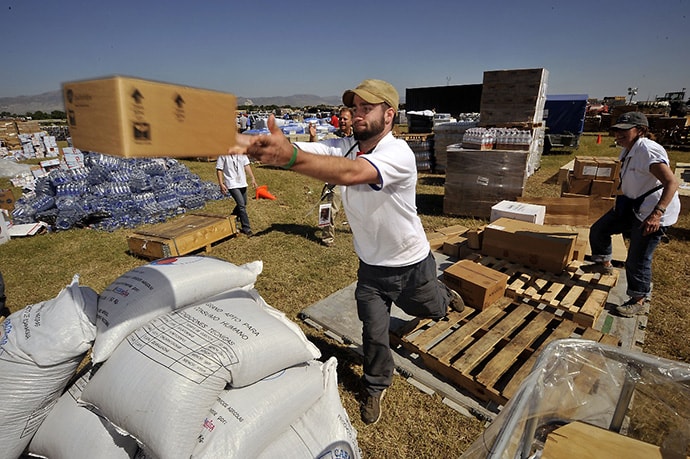
Americares relief workers unload a planeload of medicine and relief supplies in Port-au-Prince after the 2010 Haiti earthquake. Photo by Matthew McDermott/Americares.
This month marks 10 years since a 7.0-magnitude earthquake and more than 50 aftershocks devastated Haiti and forever changed global disaster response. The tragedy that struck Port-au-Prince on January 12, 2010 displaced 2.3 million people and killed an estimated 220,000 others.
Immediately after the earthquake, more than 20 countries, the United Nations and thousands of international organizations jumped to the rescue, sending people, supplies and $13.5 billion in pledges and donations. Rachel Granger, Americares’ vice-president of Global Programs, was on the ground within 48 hours of the earthquake: “Just seeing the level of devastation was heartbreaking; it was a tough thing to see,” she recalls.
To Granger, it was immediately clear that the response would be long-term. So much was visibly destroyed—buildings, roads, homes—not to mention the emotional damage to survivors, which often wasn’t visible.
But as the humanitarian response unfurled, many began to criticize the massive influx of aid, saying it was creating more chaos and problems than it was solving. A Guardian article published one week after the earthquake described conflicting calls for the U.S. or the U.N. to take charge of the relief effort. The article also quoted Haiti’s then-Prime Minister Jean-Max Bellerive, telling the Washington Post that the government was “overwhelmed” by the crisis.
Much has been written about the post-earthquake effort over the last decade, and the criticisms have not dulled. Certainly, the humanitarian sector learned some big lessons in Haiti, but there were also many things that went well.
To begin with, the world’s generosity was unprecedented. Aside from contributions from national governments, there was an astonishing amount of individual giving. The celebrity-laden “Hope for Haiti Now” telethon alone, led by George Clooney and Haiti-born rapper Wyclef Jean, raised at least $61 million. Television-viewing habits have changed drastically over the last decade, but many non-profits learned the importance of being prepared to engage supporters immediately after a disaster. Rapidly changing news cycles means the window of opportunity to reach an audience closes quickly.
Additionally, some experts have praised the immediate shelter response as “remarkable,” considering that at least 1.5 million displaced people had some sort of shelter within five months. Some of the best practices that emerged from the housing recovery process included providing conditional cash transfers to displaced families in urban areas, upgrading slums, and including informal neighborhoods as part of the housing recovery strategy. Many of these practices, especially cash transfers, continue to be important strategies for effective disaster relief and recovery.
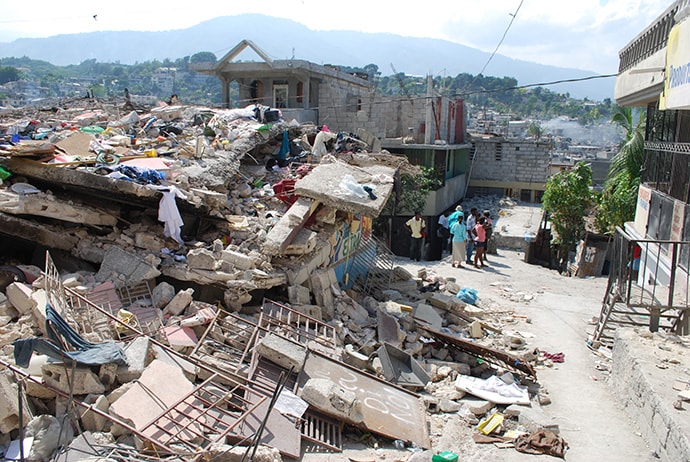
World Concern staff assess damage and assist survivors in the days following the devastating earthquake that shook Port-au-Prince, Haiti, on January 12, 2010. World Concern has worked in Haiti for nearly 40 years, and launched a massive response after the earthquake that aided thousands. Their work in Haiti continues today with disaster risk reduction and community development. Photo credit: World Concern.
The U.N. cluster system—a humanitarian coordination structure—also played a critical role in the response. Its aim is to organize and coordinate hundreds, even thousands, of humanitarian groups responding in a crisis by dividing the relief and recovery effort into 11 sectors. Each sector (or “cluster”) is overseen by relevant U.N. agencies. For example, the World Health Organization (WHO) oversees the Health Cluster, while the World Food Programme (WFP) and the Food and Agriculture Organization (FAO) oversee the Food Security Cluster. Representatives from the U.N. and the organizations within each cluster regularly attend meetings to coordinate their efforts. And at the head of it all is the Humanitarian and Emergency Relief Coordinator.
The cluster system was first introduced in 2005 in the aftermath of an earthquake that hit Pakistan. In Haiti, the cluster system was implemented within three days of the earthquake, and a 2011 report by the U.N. Office for the Coordination of Humanitarian Affairs (OCHA) considered it a notable success. Granger says it was a key source of information for organizations like Americares that were working on the ground.
However, criticisms of the cluster system soon became plentiful. Instead of streamlining efforts and creating more efficiency, critics complained that the cluster system was clunky and incomprehensible. Aid workers said they were being slowed down by countless meetings, as clusters formed “sub-clusters” and those broke down further into “baby clusters.”
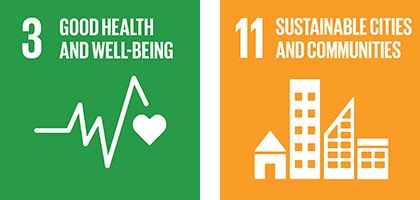
Some, like Médecins Sans Frontières (MSF, or Doctors Without Borders), called it a system failure, especially when cholera broke out in October, forming the first modern outbreak of the disease. MSF complained that resources were stuck in Port-au-Prince instead of being deployed to the rural areas that were hardest hit by the disease.
OCHA’s 2011 report acknowledged this disconnect: that linking coordination at the national level to local levels was an issue, and that there needed to be more localized coordination structures. But Andrea Binder, former associate director of the Global Public Policy Institute in Berlin, argues that Haiti 2010 should actually be analyzed as two separate disasters with two very different cluster-system performances. A senior MSF staffer told her in 2013 that the cluster system, at least the health cluster, was “actually helpful” during the earthquake response; whereas “during the cholera response, it failed us.”
Despite some ongoing debate about the effectiveness of the cluster system, the U.N. has stuck with it. A 2010 evaluation of the system, including its implementation in Haiti, concluded that five years after its introduction, the benefits “already slightly outweigh[ed] its costs and shortcomings,” and that with continued improvements, the approach had “significant potential for further improving humanitarian response.” And some have even argued that Haiti provided the necessary impetus to make those improvements.
One of the main improvements has been an emphasis on keeping the government and local institutions in charge as much as possible. In the 2010 response, cluster meetings, for example, were mostly held in English not Haitian Creole, leaving out many locals. But in 2016, when Hurricane Matthew once again devastated the island, the government asserted its leadership.
“My biggest challenge is for donors to understand this time that they must work with us,” the interim president of Haiti during Hurricane Matthew, Jocelerme Privert, told the New York Times. “They must understand that everything will go through us, and trust that we have control of the situation.”
In this way, governments can say, “Thanks, but no thanks.” That, according to Granger, has been one of the biggest changes since 2010. The official guidelines for cluster coordination, published in 2015, reflect this shift when they acknowledge that the cluster approach can be a hindrance in some cases and, therefore, should only be activated when needed. After Hurricane Matthew, the cluster system wasn’t activated, although some smaller teams from clusters responded.
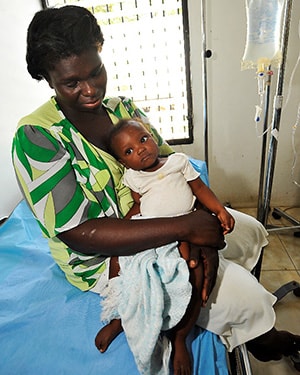
A young child receives intravenous fluids at an Americares-supported cholera treatment center in Haiti in December 2011. Cholera treatment, prevention and education was a major focus of Americares work in Haiti in the aftermath of the 2010 earthquake. Photo by Matthew McDermott/Americares.
Strong government leadership is also important for filtering participants in a disaster response. Much of the chaos in 2010 has been blamed on the deluge of first responders who had little to no experience and who were not working with each other, or with the cluster system, or with the government. That’s why there’s been a slow, but growing emphasis on building a stronger qualification system for responders. The WHO, for example, has begun certifying emergency medical teams that meet a certain standard so that Ministries of Health can easily refer to the WHO’s global registry to deploy qualified first responders. Better coordination with local institutions has also helped responders more accurately assess actual needs on the ground, so that the tragedy of wasted aid in 2010 doesn’t happen again.
Furthermore, improved partnerships and coordination extend beyond governments and NGOs. Amazon, for example, is partnering with organizations like the Red Cross, Mercy Corps, and other local non-profits to leverage its supply chain, logistical expertise, and global customer base to support disaster responses, including after Hurricane Dorian in the Bahamas and the recent California wildfires. Tech companies like Microsoft are also helping drive improvements in data collection. After the 2010 Haiti earthquake, for example, just getting an accurate death count was nearly impossible, because so many people didn’t even have a birth certificate for identification. Through technologies like biometric identification and blockchain, the U.N. Refugee Agency has been helping hundreds of thousands of refugees establish or reestablish their identities.
In the decade since the Haiti earthquake, the humanitarian sector has also grown to recognize the importance of issues that are less visible than temporary shelter and broken infrastructure. Things like mental health and gender justice across all sectors have gained recognition for the significant part they play in effective relief and recovery. Gender roles, in particular, mean that disease outbreaks, natural disasters and other life-threatening crises can affect men and women and boys and girls differently, often with a greater impact on women and girls. As traditional caregivers, for example, women may be more vulnerable to infections because they’re caring for sick family members. Mercy Corps has also found that more women and girls died in the 2004 Indian Ocean tsunami, because women, as primary caregivers, couldn’t flee as easily and because most women and girls in the culture were not taught to swim. The insecurity brought on by disasters and crises also often leads to higher rates of child marriage, which then has long-term negative impacts on child health, maternal mortality, education and a host of other human development issues.
Much in the way that the Sustainable Development Goals are far more comprehensive and focused on the intersection of issues than its predecessor, the Millennium Development Goals, the global response community has learned valuable lessons over the last decade about a more holistic and thoughtful approach to humanitarian aid. The long-term recovery process in Haiti offered a glimpse of the blurring lines between humanitarian relief, recovery, and development, as crises become increasingly complex and prolonged. More than ever, the lessons from Haiti for more effective leadership, greater coordination and better local partnerships are critical for saving lives now and in the future.
The following Global Washington members are responding to disasters around the world:
Amazon
Amazon’s disaster relief and response efforts leverage Amazon’s vast operational excellence, innovative technologies and worldwide logistics network to provide fast and effective support to worldwide operations fighting large-scale natural disasters. Amazon has filled cargo jets and shipped truckloads of Amazon-donated items for communities ravaged by hurricanes, sent solar powered lights to people living without power after tsunamis, enabled customers to easily donate products and cash on Amazon.com, and helped governments and non-profits expedite response efforts at scale through our AWS cloud services.
Americares
Americares is a health-focused relief and development organization that responds to people affected by poverty or disaster with life-changing health programs, medicine, and medical supplies. Since it was established in 1979, Americares has provided more than $17 billion in aid to 164 countries, including the United States, making it the world’s leading non-profit provider of donated medicine and medical supplies. Each year, Americares reaches more than 90 countries and all 50 U.S. states with more than $900 million in innovative health programs and quality medical aid. Americares responds to approximately 30 natural disasters and humanitarian crises worldwide each year, establishes long-term recovery projects, and brings disaster preparedness programs to vulnerable communities. Its relief workers are among the first to respond to emergencies, and they stay as long as needed, helping to restore health services for survivors. In 2018-19, Americares responded to 43 emergencies, continued 11 multi-year responses, and launched 32 new responses. Through its emergency programs, Americares provided aid to 24 countries, including six U.S. states and two U.S. territories, valued at $32 million.
American Red Cross
In the aftermath of the Haiti earthquake, Red Cross and Red Crescent teams provided food, water, medical care, emergency shelter, cash grants, and other essentials to millions of people—spending $148.5 million in the first six months alone. And when a severe cholera outbreak occurred, the Red Cross provided 70 percent of the funds needed for the country’s first cholera vaccination campaign. The U.S. Centers for Disease Control subsequently called the effort, “one of the best coordinated and documented responses to a cholera outbreak in modern public health.” Since then, Americans’ donations have funded the operations, construction or equipping of more than 50 hospitals and clinics in Haiti, as well as the renovation or reconstruction of 48 schools, and assisted more than 164,800 people through housing and neighborhood recovery. The American Red Cross ensured that the majority of its staff was Haitian; funded more than 50 organizations large and small; and made certain that all projects were driven by community members themselves—all in service of the Haitian government’s national earthquake reconstruction plan and in partnership with the Haitian Red Cross.
CARE
Responding to the needs of people affected by emergencies has been at the heart of CARE’s mission since its founding 75 years ago in the aftermath of World War II. Last year CARE provided lifesaving assistance to 12.9 million people in over 20 countries – indirectly benefiting an additional 22.8 million people. With long-term operations in more than 90 countries, CARE already has staff on the ground and can respond quickly when emergencies happen. Additionally, CARE deploys its Rapid Response Team of international emergency specialists to provide expertise in providing emergency food, water and sanitation, shelter and health services. CARE is committed to helping communities recover and rebuild over the long term. CARE is at the forefront of efforts to streamline and modernize emergency response to meet today’s complex challenges. By investing in new technology, testing and scaling up effective new practices, and collaborating with other global humanitarian organizations, CARE has taken a leadership role in modernizing decades-old practices that are no longer adequate. This includes addressing the neglected needs of the most vulnerable during emergencies – women and girls. Through community-preparedness planning, CARE equips vulnerable communities to mitigate the impact of disasters, building local capacity to respond more effectively and recover more quickly when they strike.
International Rescue Committee
The International Rescue Committee (IRC) helps people in 40+ countries whose lives and livelihoods are shattered by conflict and disaster to survive, recover, and gain control of their future. Since 1976, the IRC in Seattle has helped thousands of refugees, immigrants, and survivors of human trafficking to rebuild their lives in Washington State.
Medical Teams International
Medical Teams International is a Christian humanitarian relief agency providing life-saving medical care for people in crisis, such as survivors of natural disasters and refugees. Daring to love like Jesus, Medical Teams International cares for the whole person – physical, emotional, social, and spiritual – and serves all people – regardless of religion, nationality, sex, or race. Because every person matters.
Mercy Corps
Mercy Corps has responded to almost every global natural disaster in the last 20 years, including the 2015 Nepal earthquake, Typhoon Haiyan in the Philippines, the Japan tsunami, the Haiti earthquake, Hurricane Maria in Puerto Rico, and most recently, Hurricane Dorian in the Bahamas. After an emergency, Mercy Corps works quickly to meet the urgent needs of survivors. If local markets are operational, it provides cash assistance so that people are able to buy what they need, such as food, medicine or supplies to repair their homes. Cash gives choice and dignity to vulnerable people after a disaster, and it also jumpstarts local markets and businesses, helping them and the larger economy recover. Mercy Corps also looks to long-term solutions after an emergency, investing nearly 65% of program spending into efforts that help people build strong local economies and make communities more resilient in the face of disaster. After Hurricane Maria devastated Puerto Rico in 2017, the organization created a resilience program to help communities better prepare for future disasters, including installing solar panels so that community centers can function off-the-grid if the power goes out, encouraging families to make preparedness plans and providing disaster preparedness information, skills and equipment like satellite phones.
Microsoft
For decades, Microsoft has been providing support to humanitarian organizations of all sizes to help prepare for, respond to, and rebuild through humanitarian crises around the world. This commitment is rooted in the company’s mission to empower every person and organization on the planet to achieve more. Microsoft’s approach is to empower first responder organizations to meet critical needs, empower humanitarian organizations to drive greater impact, and empower displaced people to rebuild their lives. This is achieved through technology, cash grants, employee donations, and Microsoft staff through emergency technical support. Recently, Microsoft has been making investments with key partners to develop sustainable, stable technology with organizations to increase their resiliency before the next crisis. This work focuses on increasing organizational data collection, analysis and most importantly, automated data sharing with partners based on open data standards. Artificial intelligence and data modeling hold enormous promise for forecasting and detecting early signs of coming disasters, and can help responders better target their aid. AI technologies like machine vision can quickly analyze images of roads damaged or destroyed by an event, making way for a faster and safer response. In 2018, Microsoft launched the AI for Humanitarian Action initiative, a five-year, $40 million program to harness the power of AI to address challenges like disaster response. Microsoft has also assisted in the development and application of biometrics to assist in medical treatment of refugees. Additionally, Microsoft has invested in the development and release of an open-sourced nonprofit common data model, which it has promised to apply to its products, releasing nonprofits from the risk of technology dependency when it comes to their data.
NetHope
NetHope empowers committed organizations to change the world through the power of technology. This consortium of nearly 60 leading global nonprofits unites with technology companies and funding partners to design, fund, implement, adapt, and scale innovative approaches to solve development, humanitarian, and conservation challenges.
Oxfam
As Oxfam responds to major emergencies around the world, it also helps lead a movement to shift more power, skills, and funds into the hands of local humanitarians. When emergencies strike, everyone from community leaders to the mayor’s office to national organizations and government agencies may spring into action, but in too many places in the world, they are drastically short of resources. Yet, it is these groups that are best positioned to save lives: they can reach disaster zones quickly, and they understand the languages, cultures, geography, and political realities of the affected communities far better than outsiders. Oxfam has been working to ensure that local leaders get the funds, training, and influence they need to protect their communities to shift power and resources in the hands of local humanitarian leaders. Meanwhile, Oxfam continues to respond directly—hand in hand with local partners—to catastrophic emergencies. Oxfam installs water and sanitation facilities and distributes hygiene materials like soap to guard against disease outbreaks; helps ensure access to food and other essentials; and through advocacy work, helps disaster-affected communities stand up for their rights. For more information about Oxfam’s local humanitarian leadership initiative, visit oxf.am/localhumanitarianleadership
RenegAID
RenegAID is a nonprofit that advocates for communities affected by natural disasters. It recognizes that disasters are a lot of things to a community – terrible, tragic, deadly, and destructive. They also can be bewildering, regenerating, even hopeful. They force us to replace the old with new. Such regeneration in a community is natural and unifying. And yet, it is not the natural tendency of the disaster recovery industry to support such a natural need and desire. Solidarity and mutual aid are guiding principles for RenegAID – we believe in and stand with communities. After the Haiti earthquake, Spokane Falls Community College Service-Learning Club partnered with RenegAID to provide a focused and educational channel through which students, staff and faculty could donate. The S-L Club chose to help with the cost of fuel to get supplies to and within Haiti. RenegAID set up a donation account, providing 501(c)3 Haiti Project-specific donation receipts, and assuring that 100% of each donation went directly to the chosen cause. Currently, RenegAID continues its message on early alternative transportation in catastrophic disaster for survivor led distribution, connection and power generation. It is also developing several education components of Neighboring in Disaster and Disaster Literacy.
Tearfund
For over five decades, Tearfund has ensured communities affected by disasters receive life-saving assistance and the resources to recover quickly. When disaster strikes, the first to respond are often local people, organizations, and churches. Tearfund works diligently to reinforce the work of national and local actors, strengthening their capacity to act, and only responding directly when local capacity is overwhelmed. Tearfund and its partners work tirelessly to reach those in greatest need, particularly those not served by others. This means finding innovative ways to reach vulnerable populations in some of the most fragile states and advocating for the needs of those in hidden crises. In addition, Tearfund provides vulnerable communities in over 20 counties with training to help them rebuild after disasters and prepare for future crises so the impact is less devastating. In the last ten years, Tearfund has reached 13 million people and has seen vast numbers of communities transformed—people on the brink of disaster becoming resilient and empowered.
World Concern
World Concern implemented a massive response to the Haiti earthquake, assisting tens of thousands of survivors. World Concern’s work focused on meeting people’s immediate needs for shelter, water, medical care, and income. The organization provided transitional shelters, and cash grants to families and business owners. Since 2010, World Concern has implemented multiple disaster risk reduction projects to help families and communities be better prepared and more resilient in the face of recurring disasters, particularly weather-related disasters. World Concern’s goal is to bring the national disaster plans that are in place down to the household level, where training and equipping are needed most. Maggie Konstanski, World Concern’s deputy director of disaster response, explains, “At World Concern, we don’t see disaster as a one-time event, but always aim to leave a community more resilient and protected than before. When communities are truly equipped with early warning systems, trained on how to use them, and they’re owned at the community level, and an effective, safe plan is in place, it does save lives.” For example, Bangladesh has seen a dramatic reduction in loss of life from storms and weather-related disasters in the past several decades, largely due to widespread disaster preparedness training and equipping at the community level.
World Vision
In the first 90 days after the Haiti earthquake, World Vision assisted almost two million people, providing basic services such as food assistance; shelter; water, sanitation and hygiene (WASH) services; protection/security; non-food items; family reunification; child protection services and education. Over the next five years, World Vision would provide over 40,000 households with emergency shelters, deliver potable water for nearly two years to 90,000 internally displaced people, construct 10 schools, establish 30 child-friendly spaces, operate mobile and static health clinics reaching over 100,000 people, strengthen health services in hospitals, and so much more. The organization is capable of responding quickly, collaboratively and holistically to virtually any emergency anywhere in the world. It works to bring both immediate aid and long-term recovery to the world’s most vulnerable, providing lasting stability and hope. Since its founding, World Vision has responded to 76 disasters and emergencies in 57 countries, providing humanitarian aid to more than 20 million people.
Yemen Relief and Reconstruction Foundation (YRRF)
Since March 2015, Yemen has been experiencing a brutal war and a blockade that has severely restricted the commercial import of food, medicine and essential goods. This resulted in the largest humanitarian crisis in the world with over 80% of the population in need of aid. Yemen is also experiencing the largest cholera outbreak recorded. YRRF provides services to the most vulnerable, neediest and least accessible populations including towns bordering Saudi Arabia. The organization also provides services to mountainous areas that are hard to reach by most aid agencies. YRRF distributes food baskets that sustain a family of six for one month, reaching over 150,000 people. It provides water filters to populations with the highest cholera risk, and school supplies and bags, clothing and blankets, to thousands of children. During the major holidays, families receive meat and cash, as well as new clothing for children. YRRF also sponsors orphans and funds income generation projects. In addition, it provided medicine to five cancer centers donated by Americares and responded to the recent influenza outbreak by arranging for reagents to be shipped to Yemen. To increase its reach, YRRF works with a network of locals who are impeded in the affected communities, providing access to areas and reducing the cost of aid delivery, ensuring that funds are used efficiently and effectively.
Back to Top
Organization Profile
When Disaster Strikes, Americares Fills the Gaps in Health Care
By Joanne Lu
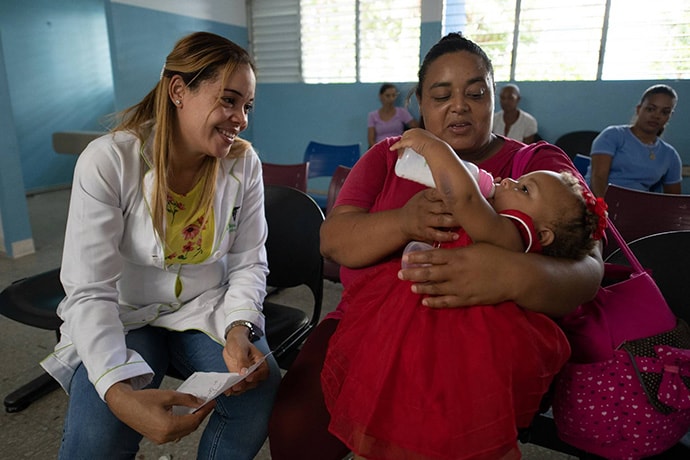
A mother and baby receive care at the Tamboril Municipal Hospital in the Dominican Republic. The hospital is a long-time recipient of Americares aid, most recently benefitting from renovations in the laboratory and on-site pharmacy, as well as mental health and psychosocial support training for staff. Photo by Jeff Kennel/Americares.
On April 4, 1975, the United States initiated Operation Babylift to evacuate thousands of Vietnamese orphans out of Saigon. But the very first flight, carrying 243 orphans, malfunctioned, forcing the pilot to crash-land the plane into a rice paddy. A third of the children burned to death, while many others were critically injured.
When the Pentagon announced that it would be more than a week before the children could be rescued, Bob Macauley, a paper broker from Connecticut, decided that was unacceptable. He immediately cut a check to charter a Boeing 747 to rescue the survivors, taking out a mortgage on his home to do so. The rescue was successful, and within 48 hours, the children were in California. A few years later, Americares was born.
Since its founding 40 years ago, Americares has stepped into crises to fill the gaps, primarily health-related ones. And to do so, they’ve built a broad network of more than 4,000 local health centers around the world that just last year reached an estimated two million people. That investment in local health centers, physicians and nurses is what sets Americares apart from other health-focused organizations, says Rachel Granger, vice-president of international programs and partnerships for Americares.
“Our global network allows us to reach a lot of people on an ongoing basis, and, in some instances, allows us to make a quicker entry into emergencies than if we didn’t already have an established network,” says Granger.
Sometimes emergencies bring Americares to countries where they already have partnerships; sometimes not. But according to Granger, their network almost always expands after an emergency.
At the heart of the organization’s work is its Access to Medicine program. This began in 1981 when Pope John Paul II, having heard of Macauley’s successful rescue mission in Vietnam, asked Americares to help airlift medical supplies to the Pope’s native Poland, which was under martial law at the time. The initial goal of $50,000 worth of supplies ended up being more than $3.2 million worth.
Today, Americares continues to support its global partners with the distribution of medicines and medical supplies donated from pharmaceutical and medical supply companies. Last year, Granger says Americares delivered the equivalent of almost 10 million prescriptions to its various partners around the world, as well as 16 million units of medical supplies.
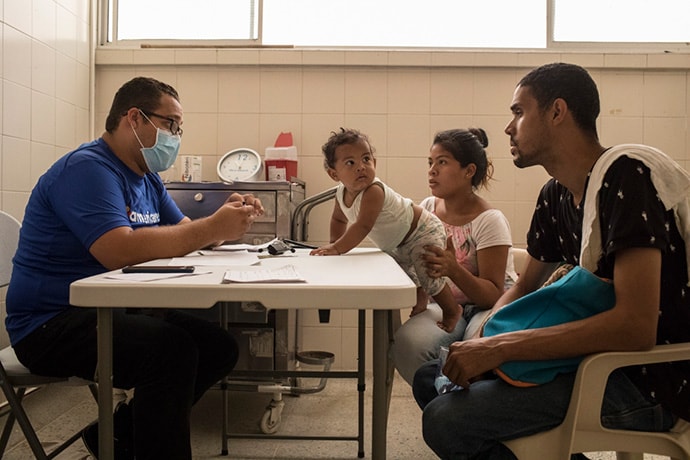
Americares operates medical clinics in Colombia for Venezuelans in need of primary care services. Photo by Nicolò Filippo Rosso/Americares.
The Access to Medicine program typically forms the basis for new Americares partnerships. Then, based on the needs and gaps, Americares helps with other technical support, training, and capacity building, all with the goal to strengthen local health systems so that they can better serve the patients under their care, even after Americares leaves a disaster area.
Working closely with local institutions has always been important to Americares.
“Anytime there’s a disaster, we want to make sure that we are supporting the local health system and the Ministry of Health at their direction,” says Kate Dischino, vice president of emergency programs for Americares. “We do not want to create parallel health systems.”
Sometimes the strengthening is literal: rebuilding and redesigning physical buildings that can better withstand future disasters and serve more patients. Sometimes, it is improving supply chains for medicines and medical supplies, rebuilding or rehabilitating warehouses to store those supplies, and implementing technologies to track items down to individual bottles. Other times, it’s training local health workers on infection prevention and control, and even mental health and psychosocial programming.
“Mental health is a critical area of the work that we’re doing these days at Americares,” says Dischino. “It’s getting more emphasis globally.”
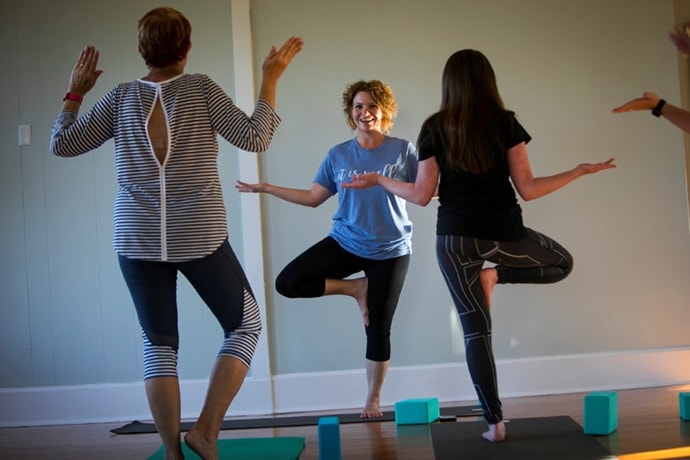
Hurricane Harvey survivors in Wharton, Texas, come together for weekly yoga classes supported by Americares Hurricane Harvey Recovery Program to help cope with stress and trauma. Photo by Annie Mulligan/Americares.
For Americares, the gap in mental health services became apparent in the aftermath of the 2011 earthquake in Japan, where they noticed that the elderly, in particular, were having a difficult time coping with being displaced from their communities. Since then, it’s become their standard to deploy mental health professionals as part of their emergency medical teams, not just for the benefit of patients, but also for the resilience and recovery of health care providers, as many are survivors themselves.
Mobile health teams have enabled Americares to really expand its reach, allowing relief workers to care for patients not only in clinical settings, but also in communities.
“The flexibility is so important because access to care is often compromised in a disaster,” says Dischino.
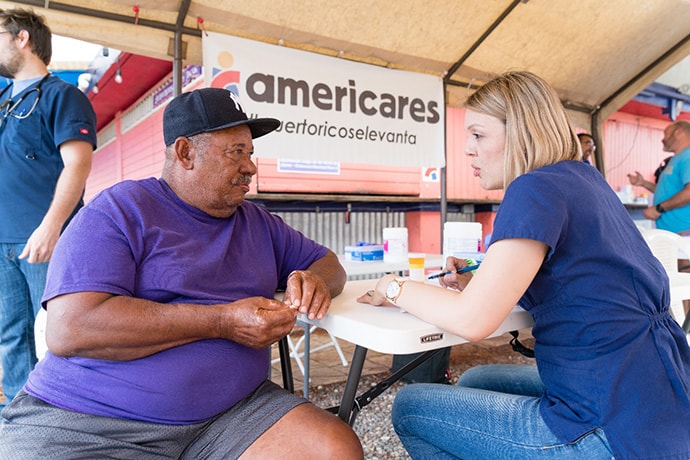
A patient receives care at an Americares mobile clinic for Hurricane Maria survivors in Vieques, Puerto Rico, in February 2018. Photo by William Vazquez/Americares.
When people are unable to access usual health services, either because transportation is limited, or their health is too poor to seek facility-based care, mobile teams are able to go further out into communities to set up “pop-up” clinics or even do home visits.
Moving forward, Americares is adding new components and rigor to its emergency response work.
This is another important lesson the global response community has learned in the decade after the Haiti earthquake: Good intentions are not enough when lives are at stake.
At the moment, Americares is in the process of securing certification from the World Health Organization (WHO) for its Emergency Medical Team initiative. This certification will help Ministries of Health more quickly and easily request qualified surge support to help them in an emergency. If Americares secures the WHO certification, they’ll be among the first American NGOs to get it. In addition, they’re compiling a “global roster” of trusted, vetted, and trained subject-matter experts that they can quickly call in the immediate aftermath of a disaster. These include both medical and non-medical personnel.
But most importantly, Americares plans to continue building on its history: a history of access to medicine, mobile care, strengthening local systems, and filling in health-related gaps wherever they find them. Many years ago, Americares tried more diversified programming to meet a variety of needs, such as rebuilding livelihoods. Although those projects were quite successful, in the end, Americares realized its place would always be in health.
“The reality is there’s always more than enough to do in health,” says Granger, “so it makes sense for us to maintain our focus, leverage our partnerships and keep our resources going to health.”
Back to Top
Goalmaker
Bettina Stix, Amazon Senior Manager of Disaster Relief
By Amber Cortes
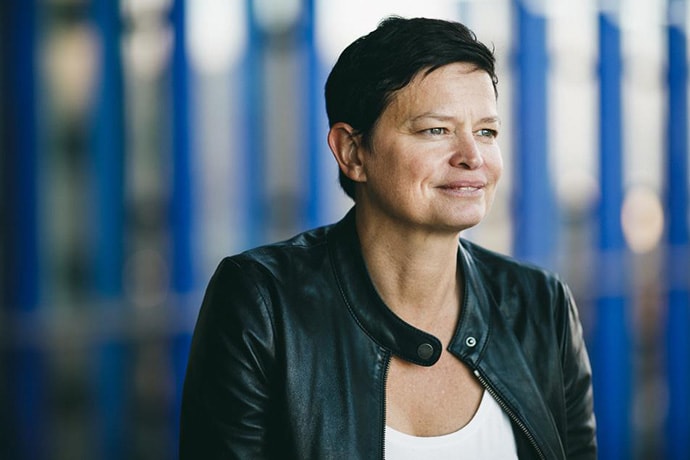
Bettina Stix, Amazon Senior Manager of Disaster Relief. Photo provided by Amazon.
Growing up in Germany after World War II, Bettina Stix is familiar with how the impacts of disasters can create forced migration, exacerbate social divides, and cause economic distress—in fact, everyone on the small, four-person Disaster Relief by Amazon team comes from a refugee background.
“All of us are definitely in some way or form shaped by our parents’ and grandparents’ experiences of being on the move, and being threatened by disasters,” she says.
Stix has been with Amazon almost 21 years in a variety of roles: shifting from editor, to project manager, to operations and customer service, to spending eight years working on Prime. During this time, Stix started thinking about how she could put her skills to use for the customers that Amazon may not reach within normal programs.
“And I thought that we have so much that we can offer right now, that I want to turn all of this into a ‘second return of investment,’ as I like to call it, and make it available in some way to communities that cannot afford what they need.”
How Stix’s vision evolved is a testament to the powerful combination of Amazon’s logistics expertise, a dynamic global supply chain, passionate employees, dedicated non-profits, and generous Amazon customers around the world.
In 2004 a tsunami struck the Indian Ocean, killing over 200,000 people in Indonesia, Sri Lanka, and India.
“It was one of the biggest disasters at that time. So, I got a call from some of our developers who had families in India. They said, we put up a donation campaign on Amazon in the U.S. Can you help us build the ability for our customers to donate across our international websites?”
Within three days, Stix and the global team she gathered had launched donation campaigns on the Amazon homepages in Germany, the UK, France, and Japan. Combined, across the U.S., they collected $15 million from Amazon customers, which went to the International Red Cross.
“And so, this experience in 2004 had never left me.” Stix says. “So I thought: how can I transform that?”
Some years later, after developing products for Amazon Prime customers, Stix decided to develop a working backwards document, a common Amazon writing practice, for the project—she wrote up a fictitious New York Times article, describing a fictitious hurricane in Florida, and put together reasons why Amazon was well-positioned to create a disaster response team.
“I was expecting resistance because this was so out of the normal business lines,” Stix says, “but instead, I just ran into open doors. Everybody wanted to help me make it successful.”
Shortly after that, Stix got permission to start a team. That first year the team had its work cut out for it—three hurricanes hit North America and the Caribbean in 2017— Harvey, Maria, and Irma—and Mexico experienced major earthquakes, as well.
Since then, the disasters, along with Amazon’s ability to respond quickly, has only increased. This year alone, the team responded to 22 disasters—floods, hurricanes, earthquakes, and more. Stix attributes the program’s success to creating an early response network with their non-profit partners.
“Our conversations with all of our partners start the moment NOAA announces a hurricane, to see how we can help them prepare.”
When Hurricane Dorian hit the Bahamas this year, the Disaster Relief by Amazon team was ready with a massive response, partnering with non-profits like the Red Cross, Mercy Corps, and a local organization called the Grand Bahama Disaster Relief Foundation. Through Amazon donations and customer donations, Amazon shipped about 40,000 relief items on three flights to the Bahamas—no small feat, considering the logistics involved.
“Some of these normal supply chains we can leverage, but sometimes we have to do a little bit of magic!” Stix exclaims. In this case it meant tapping into fulfillment center locations in Tampa and working with an import/export organization to manage on-the-ground organization, since Freeport airport in the Bahamas was nearly destroyed.
“That was all kind of an unusual procedure… that was the ad hoc part. But luckily our operations team are more than willing to help us in these exceptional circumstances,” Stix explains. Being able to organize employees, change supply chains, and coordinate quickly and efficiently is Amazon’s strong suit, and Stix urges other non-profits to consider how Amazon can leverage these strengths to help them.
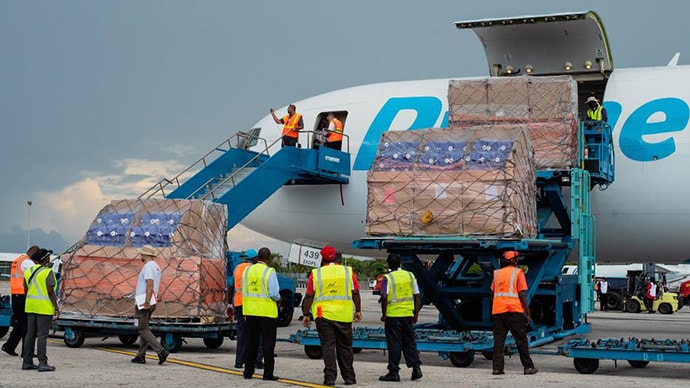
Members of the Disaster Relief by Amazon team in the field, leading relief efforts for Hurricane Dorian. Photo provided by Amazon.
“One thing I often like to say to our non-profit partners is: Don’t give me your successes. Give me what you would like to do but cannot do yet! Because that helps us better find areas where we can maybe partner together to make that happen.”
One way they do that is by prepositioning. “We work very closely with our non-profit partners to see how we can respond faster, and prepositioning supplies within our fulfillment centers is one of the things that we hear over and over.”
In another example, Amazon was able to help because of its vast product selection. During the Sonoma Valley fires in California two years ago, the scale of the devastation, which had burned entire neighborhoods to the ground, overwhelmed even the supplies of the Red Cross. They called Amazon looking for hand-held sifters—the kind someone might use to pan for gold – so that fire survivors could sift through the ashes of their homes to find anything of value that hadn’t burned. The Disaster Relief by Amazon team was able to find a vendor who could take some gold sifters out of their inventory and send them, overnight, to the Red Cross.
“Believe it or not… there’s still people going digging for gold out there, and so we had quite a few here on the West Coast!”
And last year, they got a message from the vendor, who has already set aside an extra order for this niche product.
Natural disasters tend to get a lot of media attention, since they are catastrophic and immediate, but many international non-profits are also working to address challenges that may not be covered as much by the media, but are nevertheless life-threatening, such as prolonged drought, mass displacement of refugees, and armed conflict – so-called “slow onset disasters.” But, Stix says, there’s still plenty of opportunity to engage people’s attention.
“Well, at Amazon, we have this principle for customer obsession. So, I think what works best is if you as a non-profit can really engage donors or corporations when they share with you the same obsession for the people you’re trying to help.”
The Disaster Relief by Amazon team also has another obsession: experimentation. Every disaster marks another first: Hurricane Harvey was their first time sending trucks directly into the disaster zone. After Hurricane Florence, the team was able to test out a “pop-up pickup location” where non-profits or those displaced could directly pick up supplies from a delivery container in the parking lot of a Whole Foods in Wilmington, North Carolina.
They’ve also delivered to help organizations in Indonesia, and after the floods in Mozambique, and have been working with a sister team in Amazon Web Services to see how AWS products can help with disaster response.
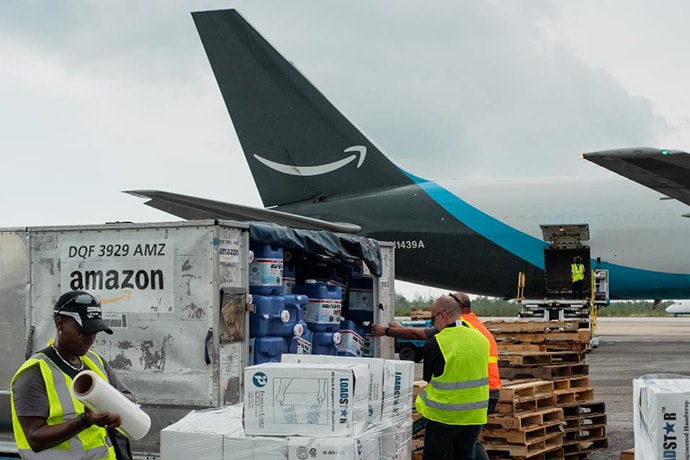
Members of the Disaster Relief by Amazon team in the field, leading relief efforts for Hurricane Dorian. Photo provided by Amazon.
Another powerful resource for the Disaster Relief by Amazon team is people’s natural desire to help. When disasters happen, people will often self-organize using available platforms, like Amazon Charity Lists, which non-profits have used successfully to guide people to the kinds of products they can most readily use in their emergency response efforts. And although sentiments are changing, Stix says many people, including many Amazon customers, would still rather send a product to those in need, than give cash.
“When you see what the needs are—and people need everything from baby diapers to clean-up buckets—the need of the population becomes just so present, you feel like you make a different type of impact when you just send what they really need.”
The most rewarding parts of her job, Stix says, are the surprising connections that happen when a community is drawn together to help before, during, and after a natural disaster.
“Just that feeling, I belong to a community and we have found ways to help that are frictionless or almost frictionless, and just engaging everybody from the non-profit, to the associate in a fulfillment center is great. It was a surprising success of that program, I must say.”
Back to Top
Welcome New Members
Please welcome our newest Global Washington members. Take a moment to familiarize yourself with their work and consider opportunities for support and collaboration!
FSC Investments & Partnerships
FSC Investments and Partnerships (FSC I&P) promotes environmentally appropriate, socially beneficial, and economically viable management of the world’s forests. A donation to FSC I&P goes directly toward supporting responsible forest management across the globe. investments-partnerships.fsc.org/en/investments-and-partnerships
Future of Fish
Future of Fish is a nonprofit systems change incubator. It works with industry players, technologists, and NGOs to create business solutions to ocean challenges. Futureoffish.org
Global Peace Foundation
Founded in 2009, Global Peace Foundation (GPF) is an international non-sectarian, non-partisan, nonprofit organization, which promotes an innovative, values-based approach to peace building, guided by the vision of One Family under God. GPF engages and organizes a global network of public and private sector partners who develop community, national, and regional peace building models as the foundation for ethical and cohesive societies. Globalpeace.org
Global Visionaries
Global Visionaries (GV) invites youth from diverse socio-economic, racial, and ethnic backgrounds to be active leaders in their local and global communities. GV is a youth led multicultural program grounded in social consciousness, collaborative leadership, and global awareness and works to empower young people to be socially and environmentally conscious global leaders. GV works toward the vision of a world where young people are boldly leading an inclusive movement for justice. Globalvisionaries.org
Human Rights Watch
Human Rights Watch (HRW) investigates and reports on abuses happening in all corners of the world. HRW consists of roughly 450 people of 70-plus nationalities who are country experts, lawyers, journalists, and others who work to protect the most at risk, from vulnerable minorities and civilians in wartime, to refugees and children in need. HRW directs its advocacy towards governments, armed groups and businesses, pushing them to change or enforce their laws, policies and practices. To ensure its independence, HRW refuses government funding and corporate ties. HRW partners with organizations large and small across the globe to protect embattled activists and to help hold abusers to account and bring justice to victims. Hrw.org
National Peace and Service Memorial/Museum
Nonprofit working to create a national memorial/museum to honor and tell the stories of all who serve the nation and the world but not in military uniform.
National Wildlife Federation
The National Wildlife Federation annually engages six million supporters across the nation in wildlife conservation activities, conservation education, and environmental advocacy. Its Seattle office collaborates directly with state agencies, conservation groups, educators and our state affiliate in Washington to protect and restore wildlife, get kids and families outside and into nature, and win on key conservation campaigns. The organization provides a variety of programs that connect individuals to the natural world and empower citizens of all ages to act on behalf of wildlife. In addition, its award-winning environmental education publications, Ranger Rick, Ranger Rick Jr., and Ranger Rick Cub, are read by 2.5 million children every month. Nwf.org
Pygmy Survival Alliance
Pygmy Survival Alliance is a nonprofit organization that connects pygmy villages in Rwanda with information, leadership, survival and health resources to enable them to transform their health and welfare. Pygmysurvival.org
Welcome Ideas
Welcome Ideas is a US based 501(c)(3) Non-Profit Corporation, operating in Zanzibar, Tanzania as a registered Non-Governmental Organization (NGO). Through education, support, networking, and pop-up facilities, Welcome Ideas helps members of the local Zanzibar community develop, finance, and operate their own tourism related businesses. By encouraging and enabling entrepreneurship in the tourism sector, Welcome Ideas hopes to reduce the economic leakage associated with tourism in Zanzibar, allowing the tourism economy to better benefit the local communities. Its programs and recruitment efforts are targeted at the economically disadvantaged, the youth, and the women of Zanzibar, individuals often left out of the tourism sector on the island. welcomeideas.org
Back to Top
Member Events
January 28: Henry M. Jackson School of International Studies (UW) – Behind the Scenes with NPR’s Correspondent in Jerusalem
February 6: OutRight International – OutRising: An Evening for Global LGBTIQ Equality
Back to Top
Career Center
Data Manger, Schools for Salone
Diversity & Inclusion, Identity and Storytelling Senior Manager, PwC
Program Manager, FSC Investments and Partnerships
Check out the GlobalWA Job Board for the latest openings.
Back to Top
GlobalWA Events
January 23: Future-Proofing Global Emergency Response Systems
February 4: Seattle Global Networking Happy Hour
Back to Top
PRESS RELEASE: Americares Responds to Puerto Rico Earthquake
Posted on January 8, 2020.
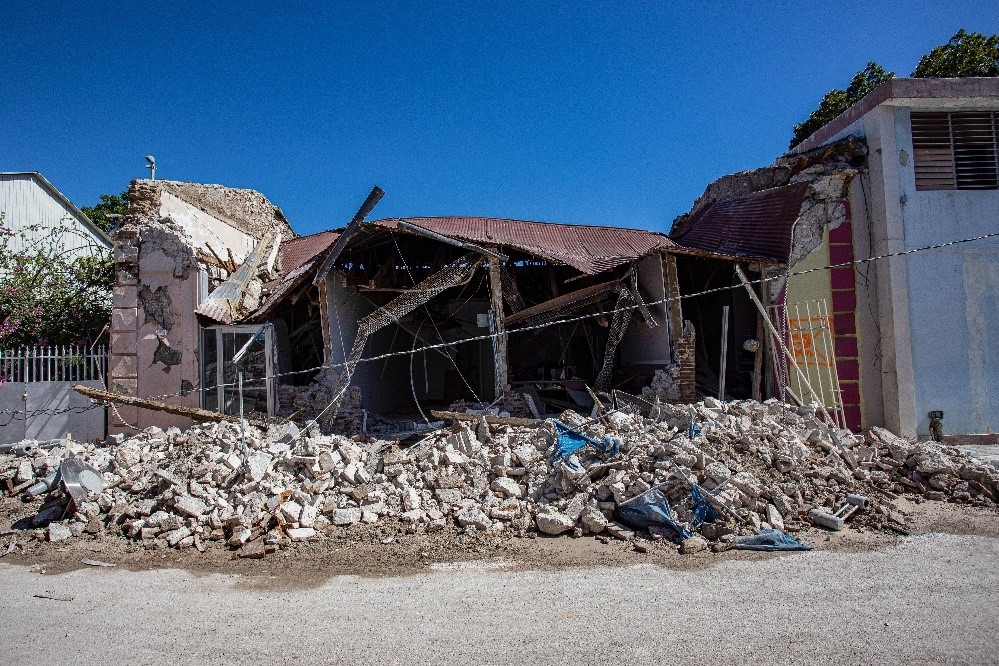
Earthquake damage in Guánica, Puerto Rico, where Americares has deployed a team of mental health experts to assist displaced families. Photo by Alejandro Granadillo/Americares.
Stamford, Conn. – Jan. 8, 2020 – Americares is responding to the devastating 6.4-magnitude earthquake that struck Puerto Rico’s southwest coast on Tuesday, killing at least one person, toppling buildings and causing power outages across the island. Gov. Wanda Vázquez declared a state of emergency and activated Puerto Rico’s National Guard, cautioning residents to prepare for additional aftershocks.
Continue Reading
December Newsletter: 2019 Year in Review
Posted on December 12, 2019.
Welcome to the December 2019 issue of the Global Washington newsletter.
Celebrating the 2019 Kick-Off of ‘Goalmakers’
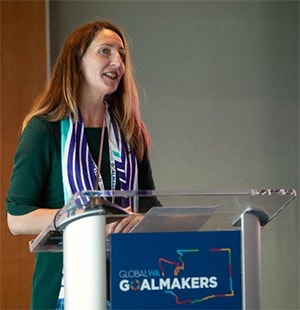
Throughout 2019 Global Washington linked our members’ work to the UN Sustainable Development Goals (SDGs), a set of 17 interconnected and indivisible goals intended to set the world on a better course by 2030.
Not only are we hearing from donors that the SDGs are a useful way to think about the kinds of efforts that they want to support, but it’s also a helpful way to visualize where the gaps are, and strategize how our network can accelerate solutions to the Global Goals.
With this in mind, we decided to rename our annual conference this year the Goalmakers Conference, in order to recognize the important role each of us – practitioners, funders, researchers, and partners – has to play in making these goals a reality.
We welcomed over 370 attendees to this year’s conference, and hosted speakers such as Raj Kumar, author, president and editor-in-chief of Devex; senior leaders at multi-media social change organizations, such as Girl Rising, Vulcan Productions, and Breakthrough; and experts in data tracking for the Global Goals from Brookings Institution, the Bill & Melinda Gates Foundation, Landesa, Microsoft, and PwC UK.
You can read about all the topics we covered in the conference report and check out photos from throughout the day. And be sure to Save the Date for next year’s conference: December 10, 2020.
In addition to the conference, Global Washington elevated 10 topics related to the SDGs throughout the year, and I invite you to take a look below at our 2019 Year in Review. You can also explore all of our past events, feature articles, and videos on our website.
Next have a look at what’s coming up with our 2020 Editorial Calendar (sub-topics and more details will be released in advance of each campaign). Please be sure to let us know how you want to get involved in 2020!
And if you want to chat with us about upcoming campaigns in person, you will find us at Optimism Brewing on December 18, together with the World Affairs Council and WGHA, for a co-hosted networking happy hour.
All my best,

Kristen Dailey
Executive Director
Back to Top
Global Washington: 2019 Issue Campaigns
Year in Review
January: Resilience & Fragile States
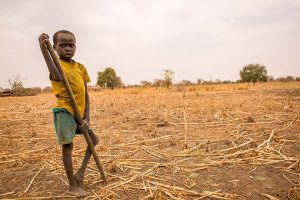
Many development experts see fragile states / fragile contexts as one of the greatest barriers to achieving the SDGs. We launched our 2019 monthly campaigns with this important topic, inviting representatives from the Bill & Melinda Gates Foundation, Mercy Corps, and Microsoft Philanthropies to offer up their perspectives. The issue campaign event, Escaping the Fragility Trap, was hosted at Microsoft campus in Redmond. In addition, we rounded out the conversation with a video interview with Jonathan Papoulidis, World Vision’s executive advisor on fragile states. Our January newsletter included a feature story on World Vision, as well as a profile of Mercy Corps’ director of evidence and influence, Rebecca Wolfe.
February: Economic Empowerment of Women
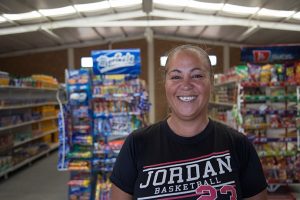
Our second campaign of the year focused on women in developing countries who increased their income and as a result, gained greater agency and decision-making in their communities. The issue-specific event, “Her Money, Her Voice,” featured speakers from Fair Trade USA, Oxfam America, and CARE. Our newsletter included a profile of Fair Trade USA, as well as a feature story on Abby Maxman, Oxfam America’s President and CEO. Abby Maxman also traveled to Seattle for a private roundtable hosted by GlobalWA.
Also in February we marked World Cancer Day (2/4) with an issue brief and round-up of all our members who are invested in cancer prevention and treatment globally. Additionally, you can read our interviews with Dr. Tom Uldrick, the new deputy head of Global Oncology at Fred Hutch, Pat Garcia-Gonzalez, co-founder and CEO of The Max Foundation, and Ambassador Sally Cowal, SVP Global Health, American Cancer Society.
March: Gender Equity – Ending Child Marriage
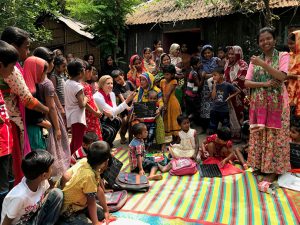
In March we focused on efforts to end child marriage globally, one of the targets in SDG 5: Gender Equality. Reaching this goal by 2030 means that progress must happen 12 times faster than over the past decade. Our issue-related event, “A Vow to End Child Marriage by 2030” featured speakers from the Seattle International Foundation (CAMY Fund), World Concern, and UNICEF USA. The March newsletter included a feature story on World Concern, as well as a profile of Perla Vazquez, CAMY Fund’s deputy program director. In March, we also promoted and co-hosted a reception for a documentary called Brave Girl Rising, a new chapter for the organization Girl Rising to promote gender equity.
April: Clean Water – Failing Fast Forward
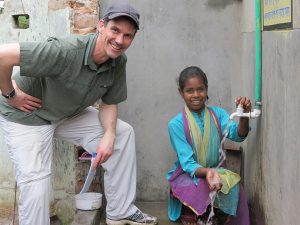
According to UNICEF, somewhere between 30 and 50 percent of water, sanitation and hygiene (WASH) projects fail after just two to five years. It should be noted that many development efforts face challenges of sustainability, not just WASH, but for our April campaign we wanted to invite Global Washington members that have iterated and improved upon their water projects to identify approaches that help drive success. The April newsletter included a feature story on WaterAid and a profile of Kirk Anderson, the director of international programs for Water1st. We also included an article from our blog written by Splash about their program, Project WISE (WASH-in-Schools for Everyone). Our issue-related event “Failing Fast Forward: Learning to Build Water Systems that Last,” included speakers from Water1st, Splash, MSR Global Health, and WaterAid. We also invited members to bring interactive displays of their interventions and explain how they work.
Also in April, we held a one-day issue campaign around World Malaria Day (4/25) highlighting progress on multiple fronts, including data tracking, a promising experimental vaccine, AI-equipped diagnostics, and better awareness-raising efforts.
May: Global Health – Investing in Birth Attendants
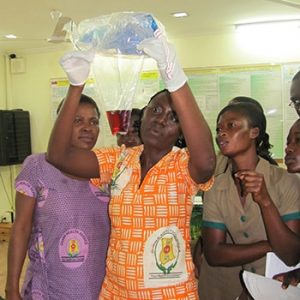
For our May global health theme, we explored the role of trained birth attendants in reducing maternal and newborn deaths. The theme coincided with the annual Women Deliver conference in Vancouver, B.C. that focused on equity issues in global health. The May newsletter included a feature story about the Maternal, Newborn, Child Health & Nutrition Program at PATH, as well as a profile of Heidi Breeze-Harris, the executive director of PRONTO International. The related event Mother, Baby, Provider: Completing the Triangle included speakers from PRONTO International, Worldwide Fistula Fund, Health Alliance International, and Kati Collective. A video of the event can be found here. As part of this campaign, we also did a video interview with Dr. Eleanor Nwadinobi, a steering committee member for Every Woman Treaty.
June: – How Can Wildlife Conservation Support Human Development?
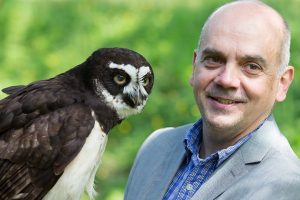 Conservation and human development are often presented as two separate issues with little overlap. But after a UN assessment found that a million plant and animal species are at risk of extinction within decades, we decided to focus our June campaign around how these two issues are inextricably linked. The June newsletter included a feature story on Vulcan as well as a profile of Alejandro Grajal, the president and CEO of Woodland Park Zoo. We hosted a VIP Roundtable with Alejandro to discuss the global movement for wildlife conservation. GlobalWA also co-promoted a related event hosted by the World Affairs Council on Illegal Wildlife Trafficking: Local Efforts on a Global Threat.
Conservation and human development are often presented as two separate issues with little overlap. But after a UN assessment found that a million plant and animal species are at risk of extinction within decades, we decided to focus our June campaign around how these two issues are inextricably linked. The June newsletter included a feature story on Vulcan as well as a profile of Alejandro Grajal, the president and CEO of Woodland Park Zoo. We hosted a VIP Roundtable with Alejandro to discuss the global movement for wildlife conservation. GlobalWA also co-promoted a related event hosted by the World Affairs Council on Illegal Wildlife Trafficking: Local Efforts on a Global Threat.
In June we also marked World Refugee Day (6/20) by focusing on “Climate Refugees” and how our members are increasing the resilience of communities at risk, as well as helping to relocate climate migrants. Check out this video interview on the issues with Fatema Sumar, VP of Global Programs at Oxfam America.
July: Human Rights – Ending Human Trafficking
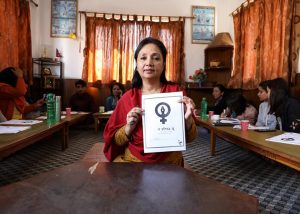
Our July issue campaign focused on the ways in which our members are working to end human trafficking and modern slavery. The July newsletter included a feature story on the group Every Woman Treaty as well as a profile of Veronica Fynn Bruey, an affiliated-faculty member at Seattle University School of Law. The issue-related event Tackling Trafficking included speakers from FRDM.co, International Rescue Committee – Seattle, Every Woman Treaty, and Resonance. In July, GlobalWA also hosted a VIP Roundtable with Michelle Nunn, CEO of CARE who gave an overview of her work, including access to education for girls to prevent trafficking.
August: Education – Global Citizens and Ethical Leaders
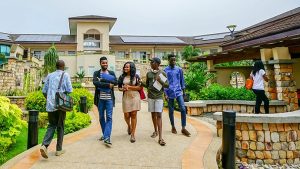
Quality education is an important enabler for many Sustainable Development Goals, including good health, reducing inequalities, tackling climate change and building peace. Our August campaign looked at the ways in which GlobalWA members are cultivating ethical leadership as a foundation for sustainable development. Our August newsletter included a feature story on Ashesi University Foundation and a profile of Mahnaz Javid, president & CEO of Mona Foundation.
September: Access to Finance – Beyond Microcredit
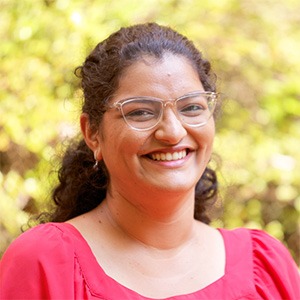 Our September campaign explored how microcredit has become an integral part of an evolving suite of financial tools designed for people with limited financial resources, including impact investing, digital payments, and job creation programs. The September newsletter featured new member, Einstein Rising, and also profiled Uma Sekar, the Director of Impact and Fund Manager Advancement at Capria. We also included a story from our blog by Upaya. In a campaign-related event, we hosted an invitation-only roundtable discussion on financial inclusion through digital payments and crypto-currencies with Mercy Corps, Dalberg, DIAL, and the Bill & Melinda Gates Foundation.
Our September campaign explored how microcredit has become an integral part of an evolving suite of financial tools designed for people with limited financial resources, including impact investing, digital payments, and job creation programs. The September newsletter featured new member, Einstein Rising, and also profiled Uma Sekar, the Director of Impact and Fund Manager Advancement at Capria. We also included a story from our blog by Upaya. In a campaign-related event, we hosted an invitation-only roundtable discussion on financial inclusion through digital payments and crypto-currencies with Mercy Corps, Dalberg, DIAL, and the Bill & Melinda Gates Foundation.
October: Food Security – Community-led Development
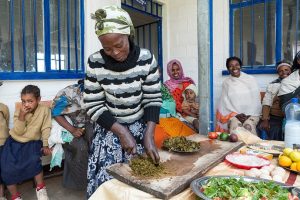
Our October campaign examined what it takes to involve communities in establishing long-term food security, including establishing effective collaboration and integrated approaches. The related campaign event included speakers from Agros International, The Hunger Project, and World Vision.The October newsletter featured The Hunger Project’s Movement for Community Led Development, and a profile of Pierre Ferrari, the president and CEO of Heifer International. Additional articles included a piece on Landesa’s ambitious “Stand for Her Land” multi-stakeholder advocacy campaign, as well as an article about new food and agriculture innovations in development by Global Good. And finally, we recorded a video interview with Heifer International’s Chief of Mission Effectiveness, Hilary Haddigan.
Back to Top





 Growing up in South Texas close to a fluid border, Amanda Klasing saw deep inequality firsthand and wanted to do something about it from an early age. From a deeply religious family whose faith was informed by social justice, she always knew she’d have a career and a life that included service. What she didn’t realize then was that her life’s work would require her to face an inherent tension in her upbringing.
Growing up in South Texas close to a fluid border, Amanda Klasing saw deep inequality firsthand and wanted to do something about it from an early age. From a deeply religious family whose faith was informed by social justice, she always knew she’d have a career and a life that included service. What she didn’t realize then was that her life’s work would require her to face an inherent tension in her upbringing.



 While developing countries are suffering the most from climate change, vulnerable communities in wealthy countries are being disproportionately affected, as well. A
While developing countries are suffering the most from climate change, vulnerable communities in wealthy countries are being disproportionately affected, as well. A 
























 Conservation and human development are often presented as two separate issues with little overlap. But after a
Conservation and human development are often presented as two separate issues with little overlap. But after a 

 Our September campaign explored how microcredit has become an integral part of an evolving suite of financial tools designed for people with limited financial resources, including impact investing, digital payments, and job creation programs. The
Our September campaign explored how microcredit has become an integral part of an evolving suite of financial tools designed for people with limited financial resources, including impact investing, digital payments, and job creation programs. The 